The living room is one of the most frequently used rooms in the home, a space that is both social and private.
It's a place in which to entertain guests, or to use for quiet relaxation with a good book or for watching television, listening to music or playing games.
As such, the living room is a space that needs careful consideration when it comes to decor and furnishing.
Before you commit to a redesign, or even a minor overhaul, it's worth asking yourself a few questions.
Do you use your living room mostly in the evenings, or do you find that it's the room you choose as your base on days when you are working from home?
Does your living room need to double up as an occasional spare room, or is it a small and cosy spot used solely for watching television?
Use the time of day that you use your living room as a guide for the colour palette. If you spend most of your evenings in your living room, a dark and cocooning colour can work brilliantly.
But something vibrant and dramatic might be just the ticket if you use your living room as a sociable space for entertaining.
The purpose of the room is a key consideration when it comes to choosing furniture – a good sofa bed is essential if your living room is also going to be used for guests staying over.
If you work from home then a good desk, or a cabinet that can hold your work files will ensure that you can keep some separation between working life and home life.
Lighting is another consideration – task lighting for desks, mood lighting for side tables, and a good overhead light for when you need to prep the space for the arrival of friends of family staying over.
Living Room Ideas
Keep it simple with blended neutrals
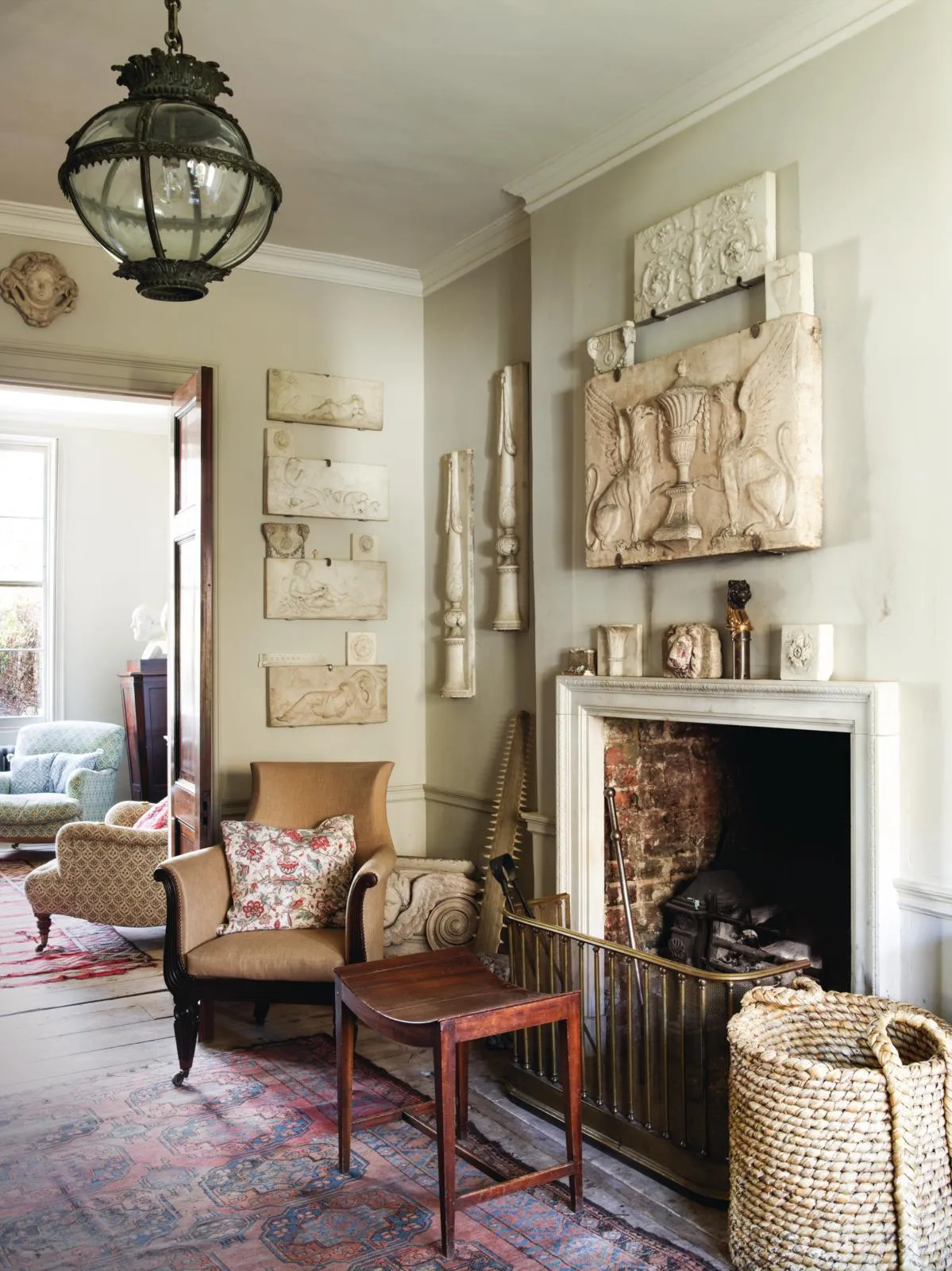
Decorating with neutrals is a fantastic way to create a cohesive and calming space, and it's a clever way to build a scheme that can be extended to other rooms to achieve a sense of flow throughout your home.
Pale neutrals, such as the shades in Will Fisher's 18th-century home are an excellent choice for monochrome displays of architectural details and sculptural friezes.
Will used the lightest slate shade available from Paint Library, describing it as 'one of those colours that works in shade and also in strong light and contrasts fabulously with stone reliefs.'
Add contrast to your living room by mixing old and new
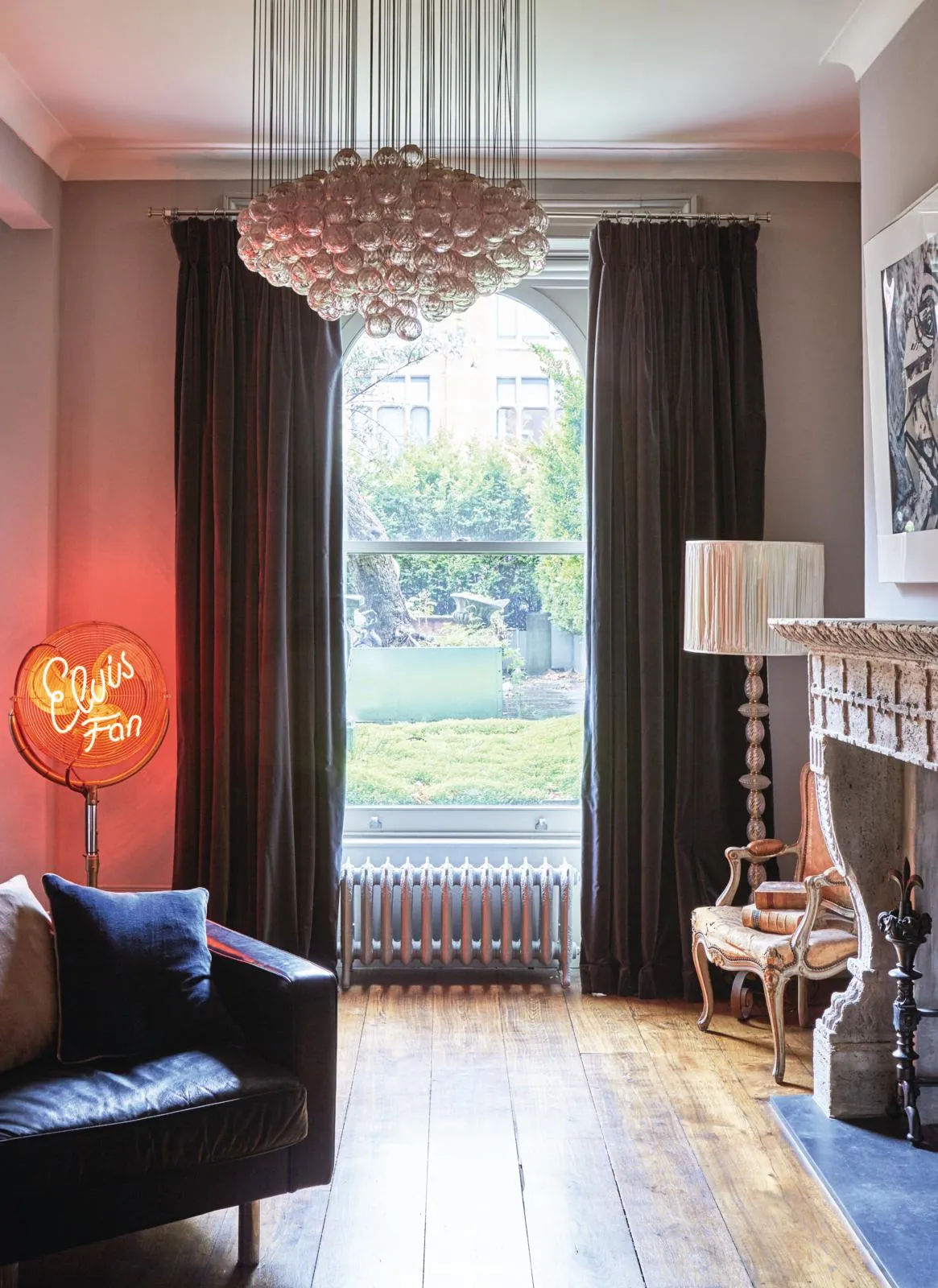
Nothing adds character to a property like blending old with new. In Owen Pacey's converted Victorian pub, the living room is an exciting and elegant showcase of antiques alongside contemporary items – the witty "Elvis fan" decorated with neon lights faces an impressive 19th-century Italian fireplace opposite. This approach gives a fresh twist to a more traditional aesthetic ensuring that nothing feels dated.
Make your living room feel bigger with light paint colours
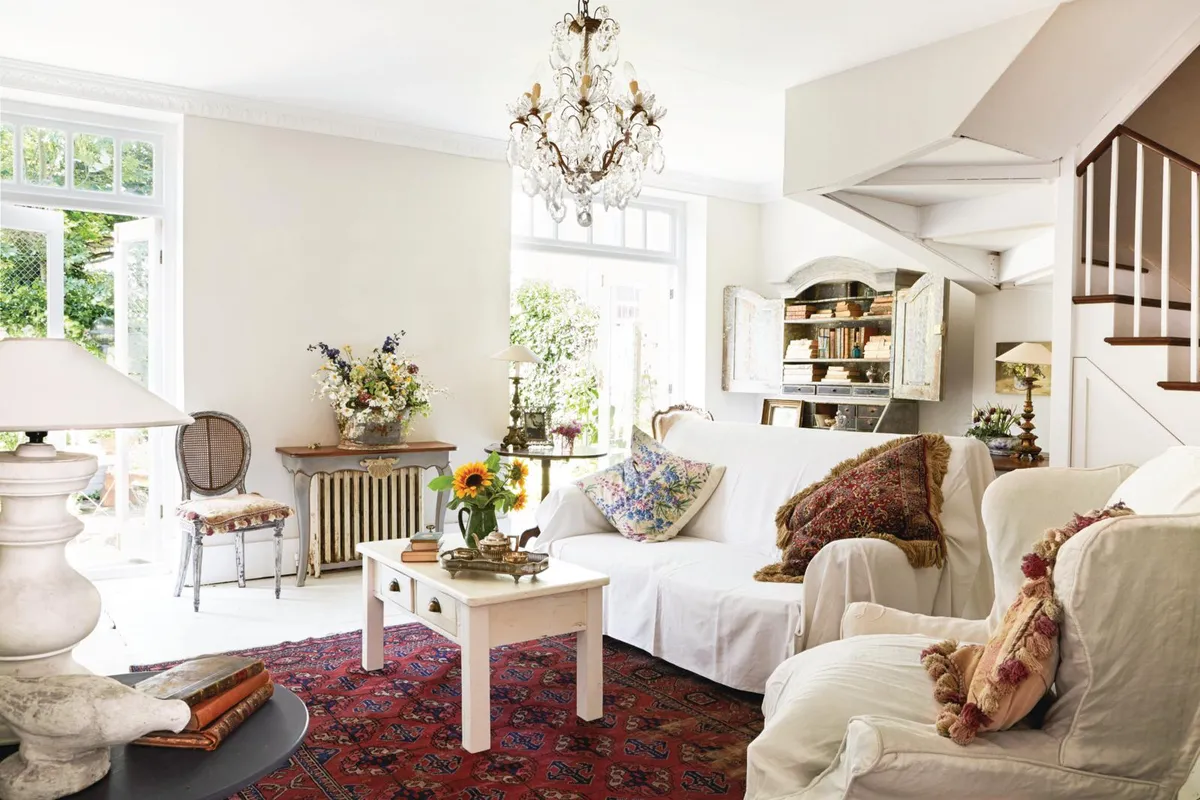
Period homes, built and designed for simpler times, can be tricky to adapt to contemporary living: low ceilings, wonky walls and awkward corners are common problems, and when combined with small cottage windows, rooms can sometimes feel small and dark.
If you're tasked with decorating a small, oddly-shaped room or you're struggling with low ceilings and a lack of light, an easy fix is to paint your living room in shades of white. In Sheila Wallace's Regency villa, the living room is a masterclass in the use of white as a brilliant backdrop for interesting antiques, enlivened with pops of colour to create further interest.
Dark and delightful
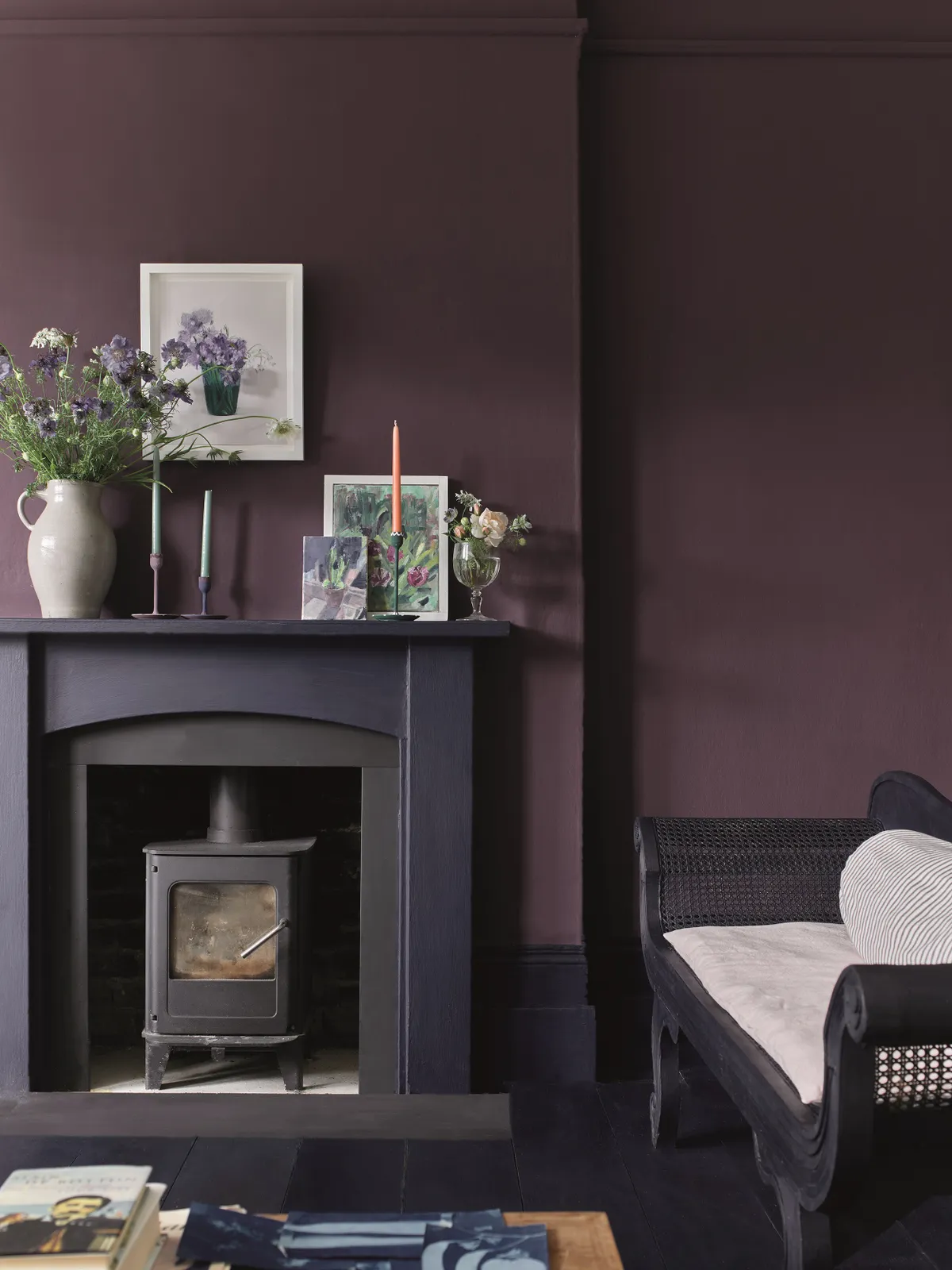
Homeowners often shy away from dark colours fearing that such shades will make a room look small and unwelcoming. But in fact, dark colours can give your living room heaps of character and personality, and actually make the space look larger.
This plum purple tone from Annie Sloan is a perfect example, the colour has been used on walls, cornice and ceiling to create a sense of volume and space, the walls appear to float away rather than close in. The fireplace and skirting boards, painted in another dark shade, close to black, create a subtle contrast and ground the space.
Play with paper
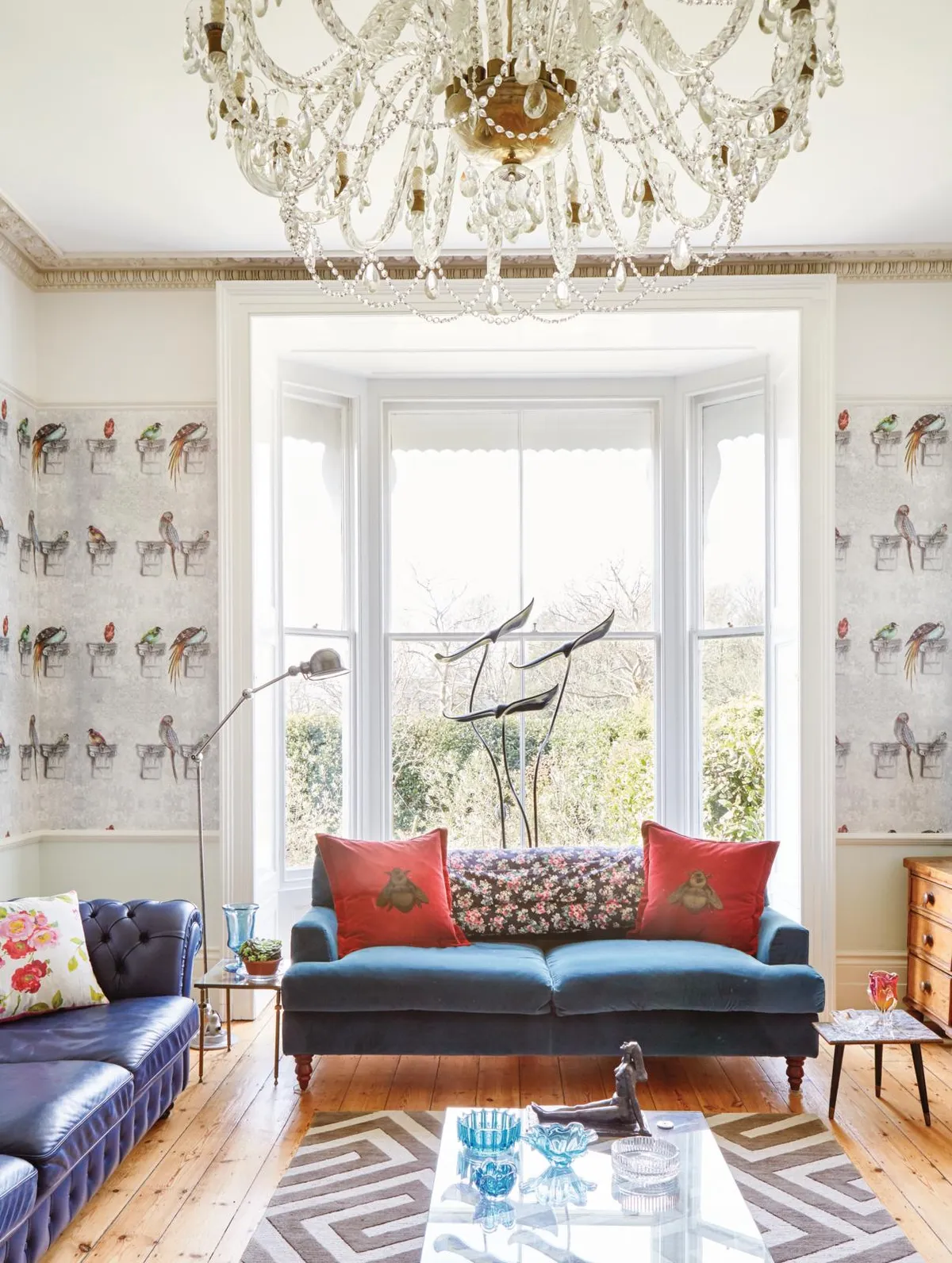
If you're lucky enough to live in a Victorian home with high ceilings, you have plenty of wall space to experiment and get creative. In the living room of Louise Convert's Victorian home, wallpaper has been used in the section between the dado rail and the picture rail, to create a band around the centre of the room.
With clean white walls above and below, the pattern takes centre stage. Not only does this bold approach offer an interesting design feature, but it also draws the eye towards the window, emphasising the beautiful surroundings.
Add storage with built-ins
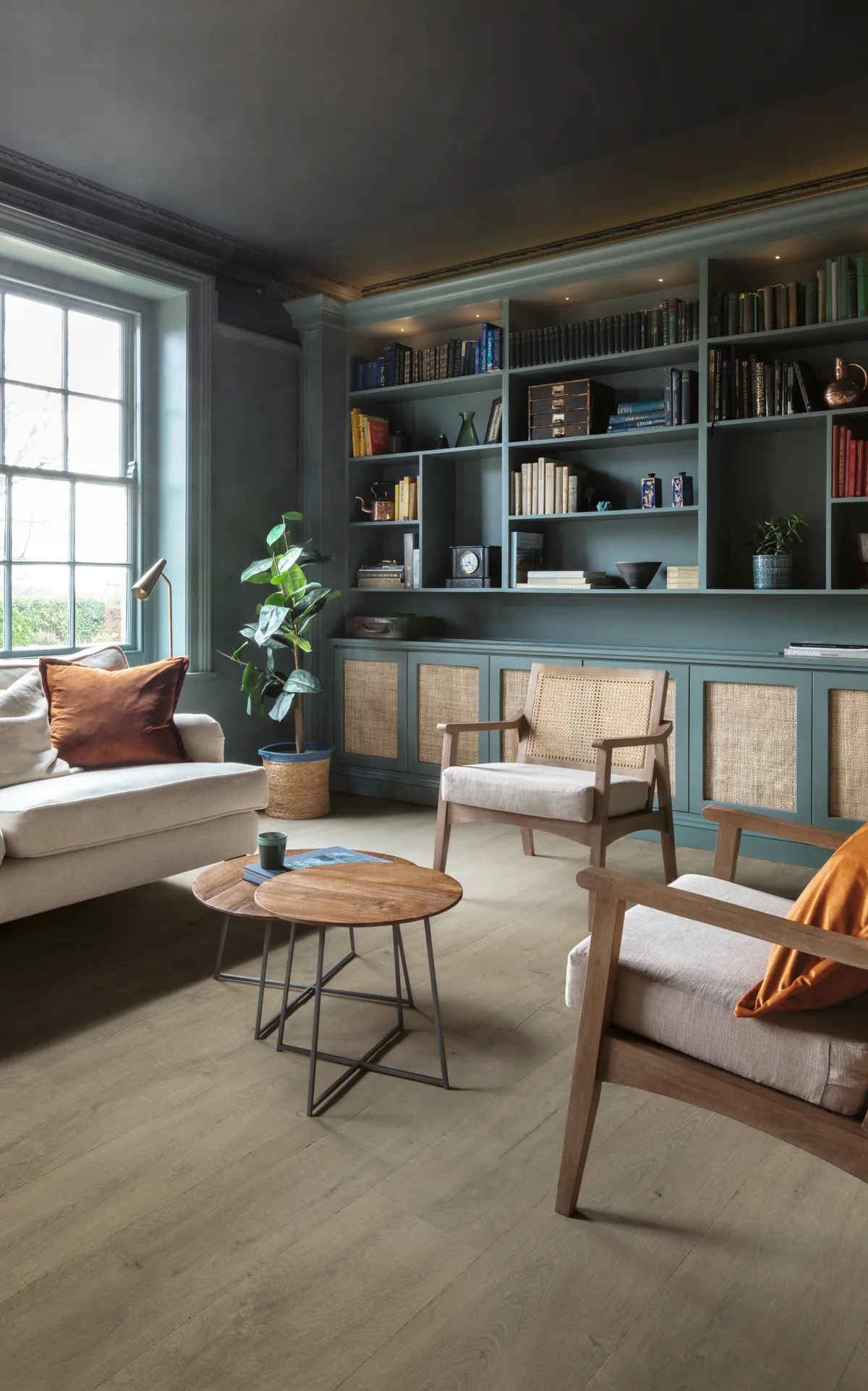
Living rooms are often one of the largest rooms in the home, and as such, you typically find yourself with a lot of wall space, which, when left empty, can make the room feel cold and unwelcoming.
Turning this space over to built-in shelves for books or display is a stylish and practical solution. Not only does cabinetry look smart, but cupboards will hide the unsightly necessities often found in a living room, and shelves give you a space to get creative and create displays of your favourite books, ornaments and antiques.
Back to black
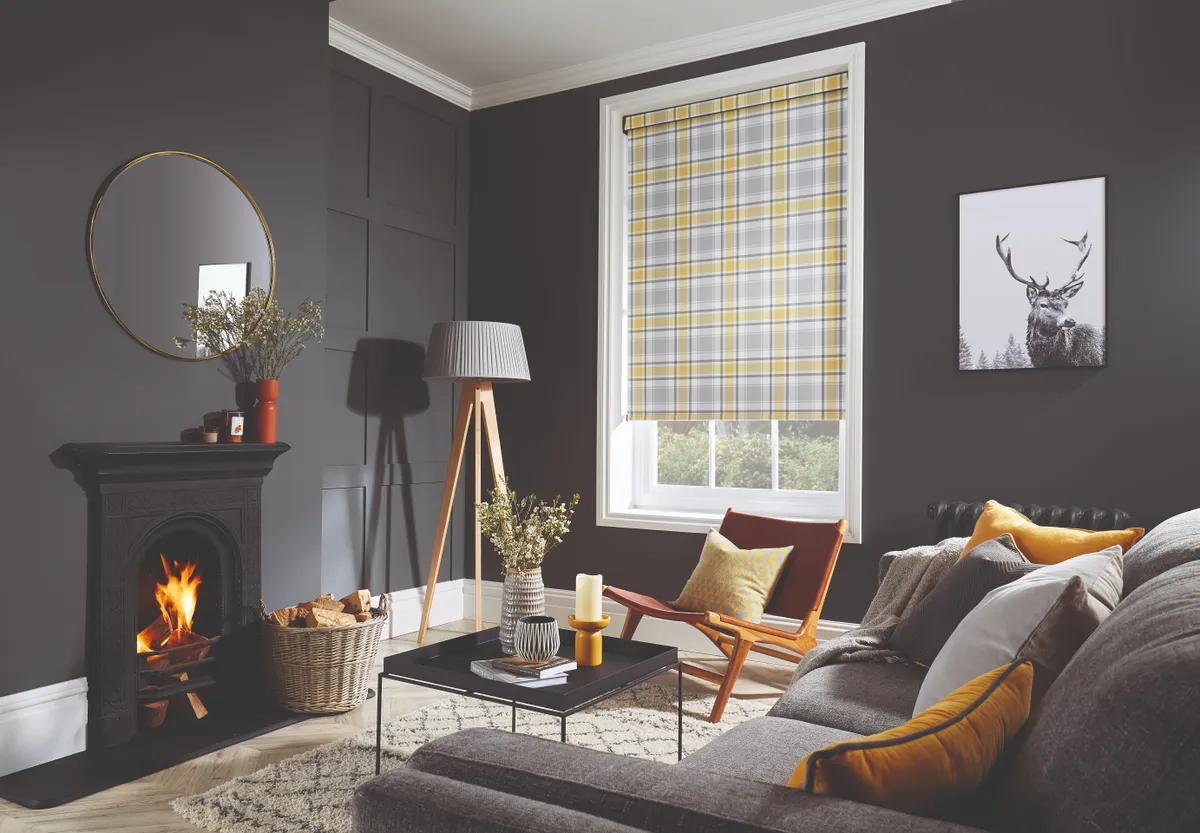
Painting your entire living room black might feel like a frightening prospect, but when it's done right, you can truly make your living room feel cosy and well-considered.
In this living room, black walls are contrasted by white woodwork and pops of yellow in the textiles, including a statement blind from English Blinds. This is a particularly good solution for small rooms that don't benefit from much light and which are mostly used in the evenings. The space will immediately feel warm and cocooning.
Go bold with a hand-painted mural
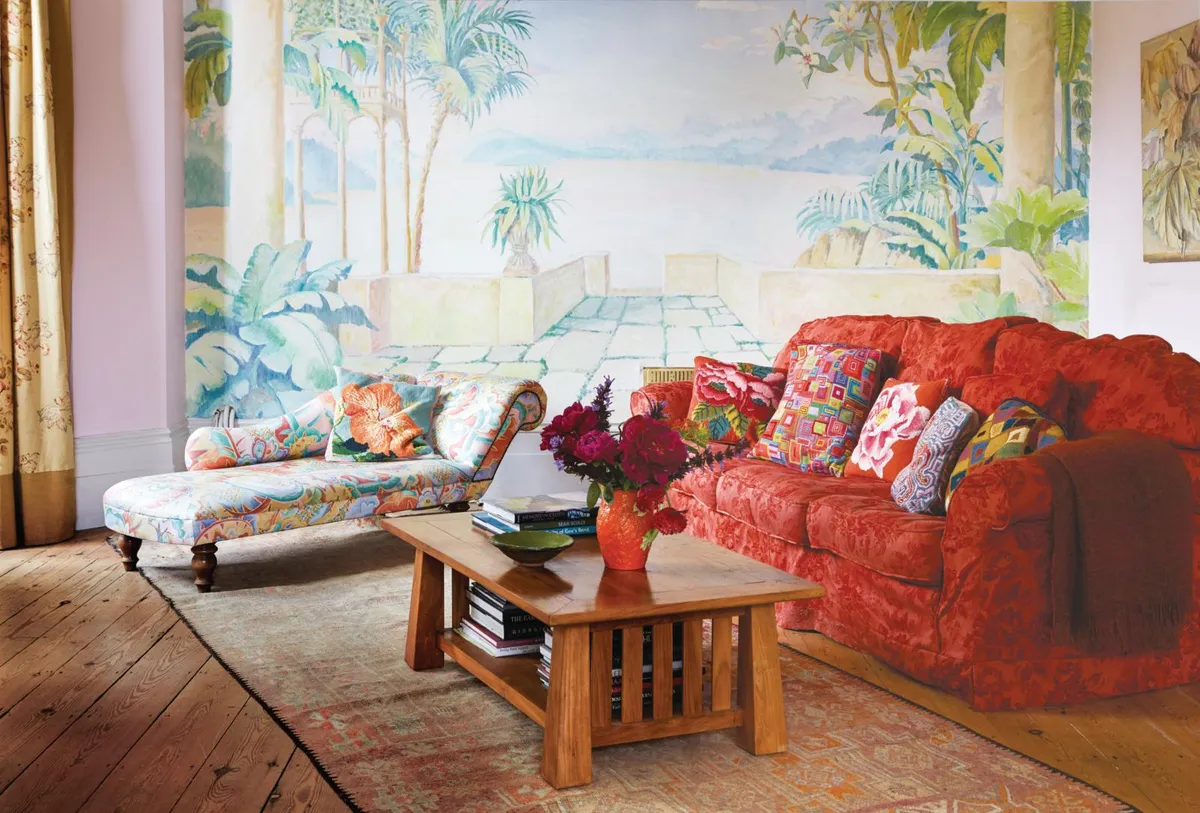
For a really unique feature, a hand-painted mural is hard to beat. By incorporating a few architectural details from elsewhere in the room – a high skirting board for instance, which can then be used to create a trompe l'oeil wall that will lead the eye into the illusion.
Make a feature of interesting details
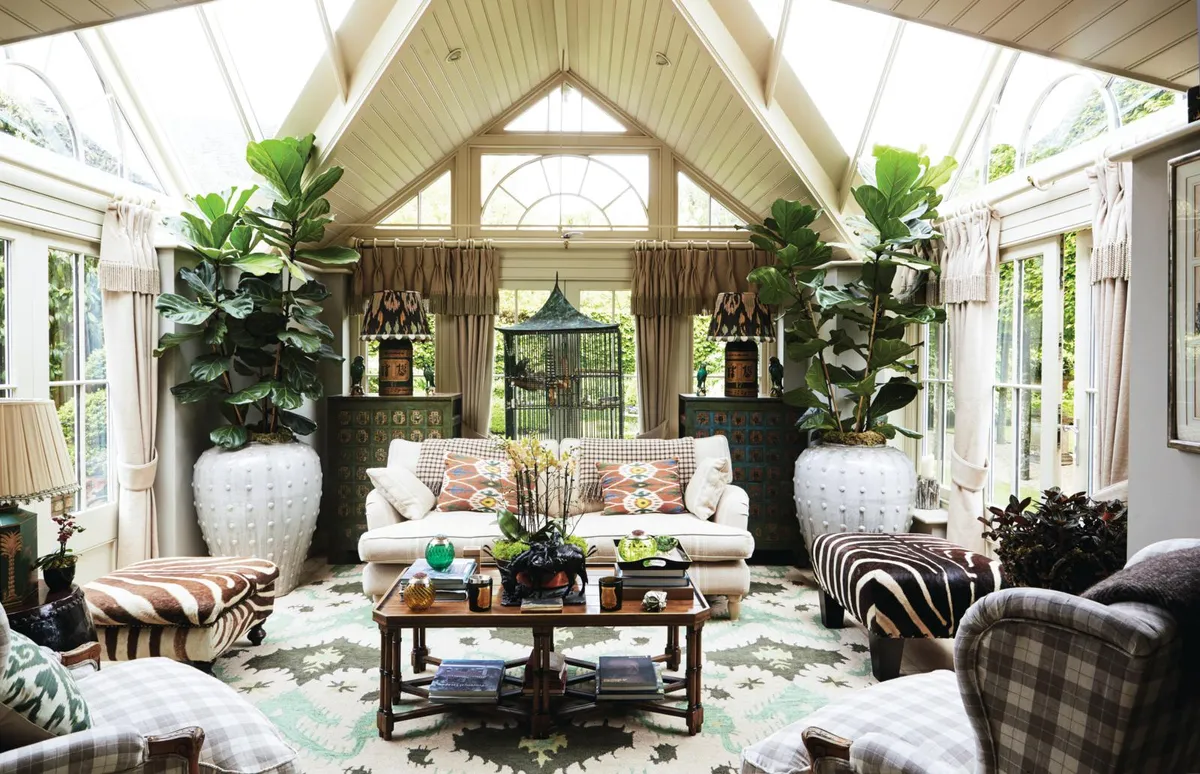
In Katie O’Sullivan’s former malthouse home, the living room benefits from architecturally interesting ceilings, so encouraging people to look up as they walk in makes sense.
To do this, Katie has experimented with scale, using oversize planters with spectacular architectural greenery that leads right to the top of the room, naturally drawing the eye upwards.
Fill the walls with art
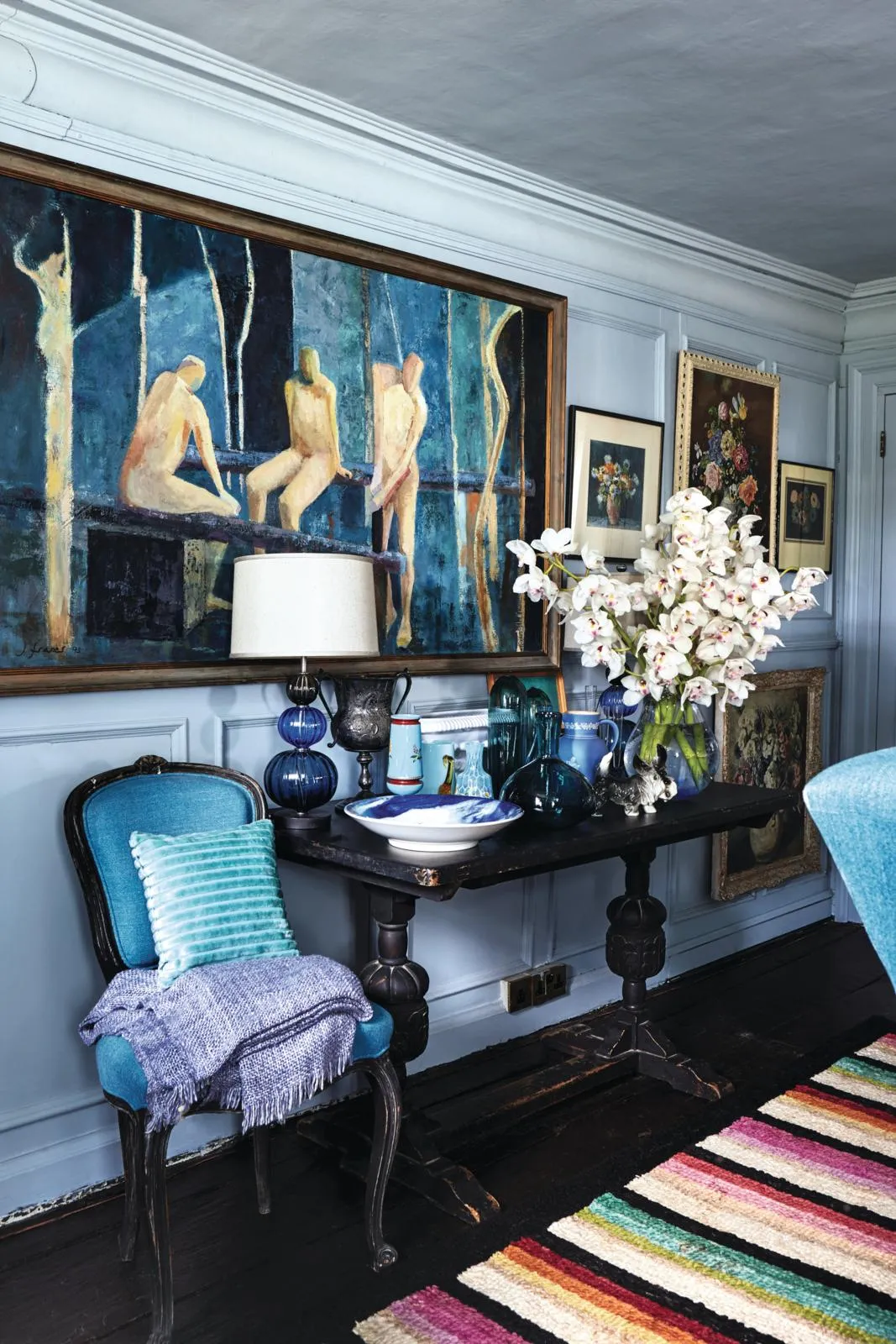
Any wall can be transformed with some carefully selected artwork. These works can also help you decide on your colour choices for the walls. In Nikki Tibbles' country house, the palette of varying shades of blue reflects the dominate colours in the large painting above the console table.
These shades have been combined to add depth to the living room: light blue paint has been used on the walls from floor to ceiling, while chairs have been upholstered in brighter blue hues all of which combine to make the space feel welcoming and interesting, while also reflecting the owner's tastes and passions.
Embrace original features
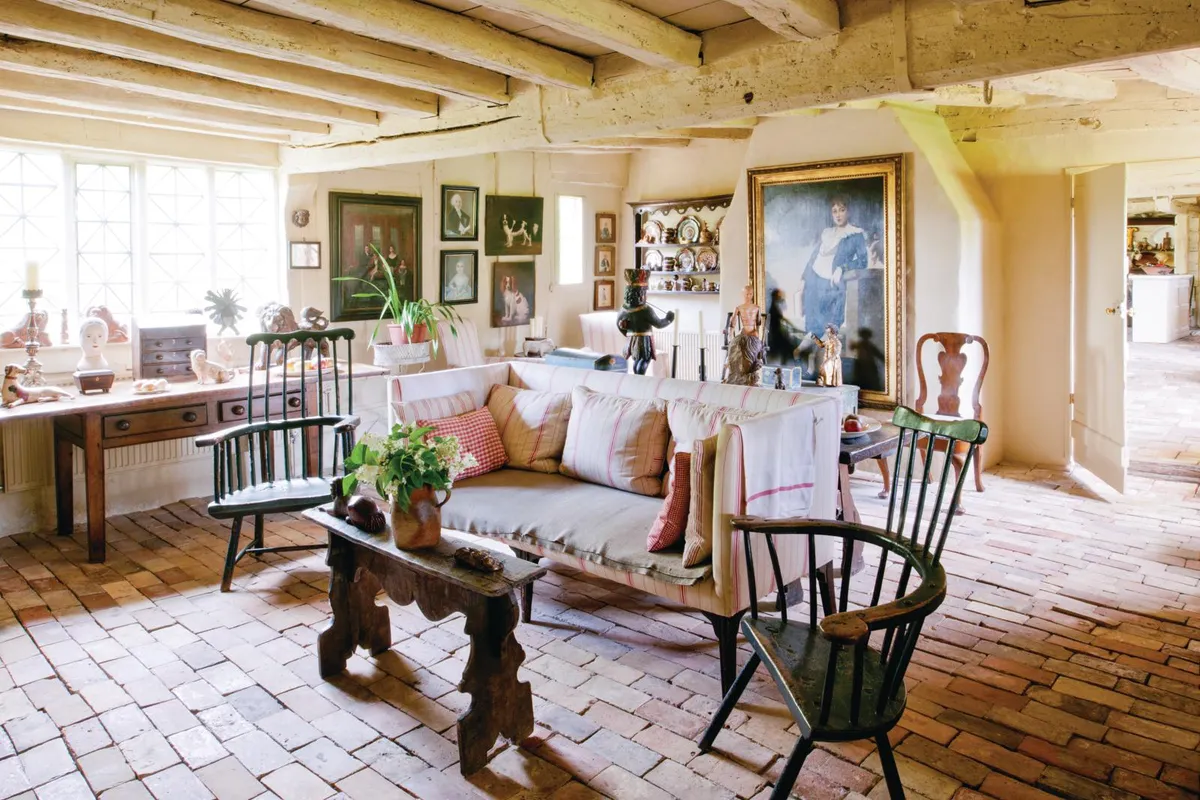
Period homes are often filled with quirky, original features that ensure your home feels visually interesting without even trying! In this lovely example, the exposed wooden ceiling beams and original brick flooring have been cleaned up but not over-restored, giving the living room heaps of character.
Antique furniture has been selected to complement the traditional aesthetic of the space, and a neutral colour palette allows the beautiful of the architecture to really stand out.
Lean into maximalist interiors
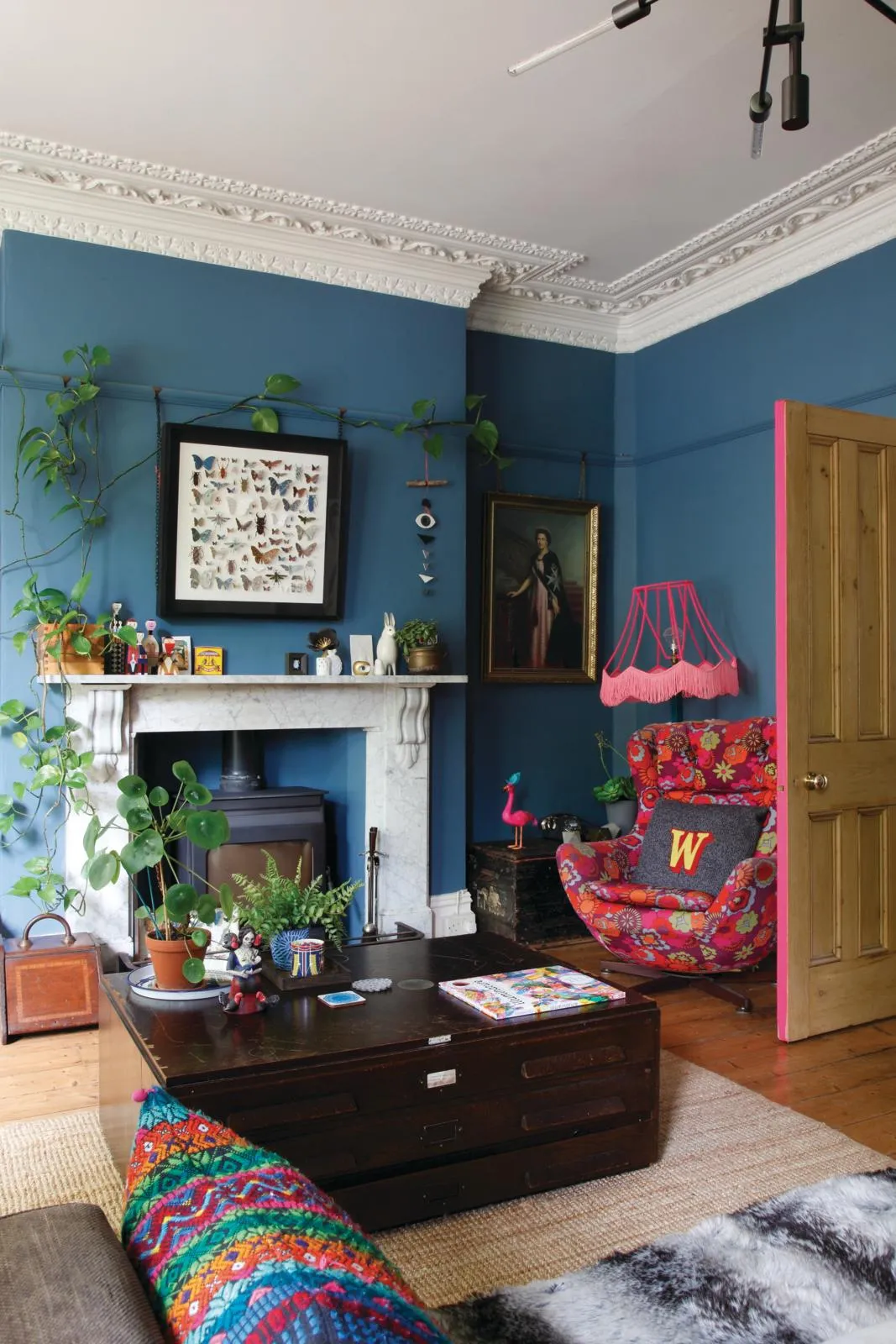
If you're a lover of all things bright, bold and beautiful, a maximalist living room might just appeal. In Helen Ward's Edwardian home, the living room has been painted deep blue, the perfect foil for the bright pink upholstery and the classic white marble fireplace and an ever-growing collection of lively house plants.
Create a cosy reading nook
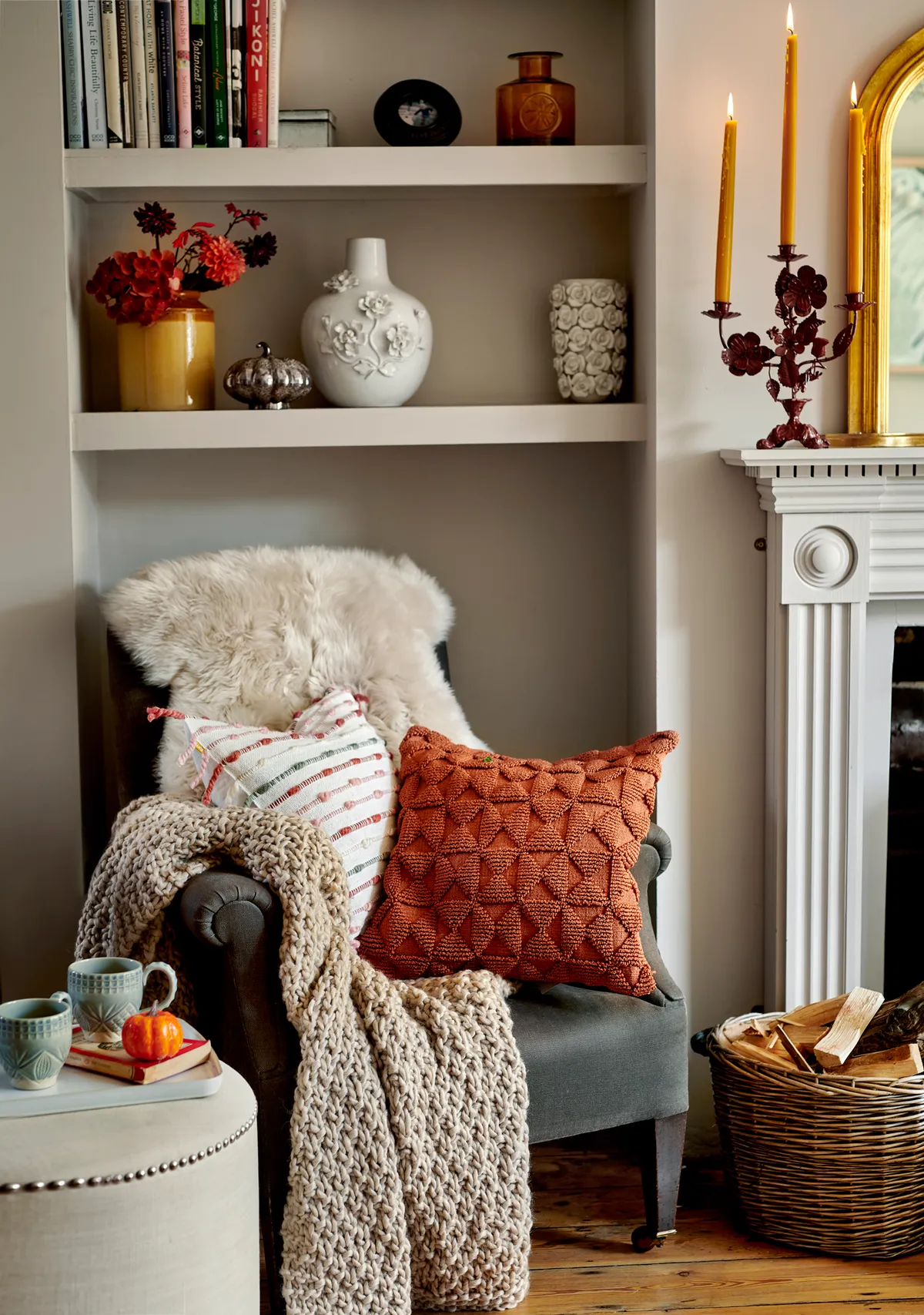
If you love to curl up with a book in the evenings, why not create a cosy reading nook in the corner of your living room?
Select a favourite armchair – or just the most comfortable one – and then choose the most suitable corner, ideally away from the distraction of the television.
An alcove bookshelf and a low side table on which to settle books and a drink are pretty much all you need. If you have the space, a window seat is also a lovely way to relax and enjoy the natural space that surrounds your home.
Try colour-drenching
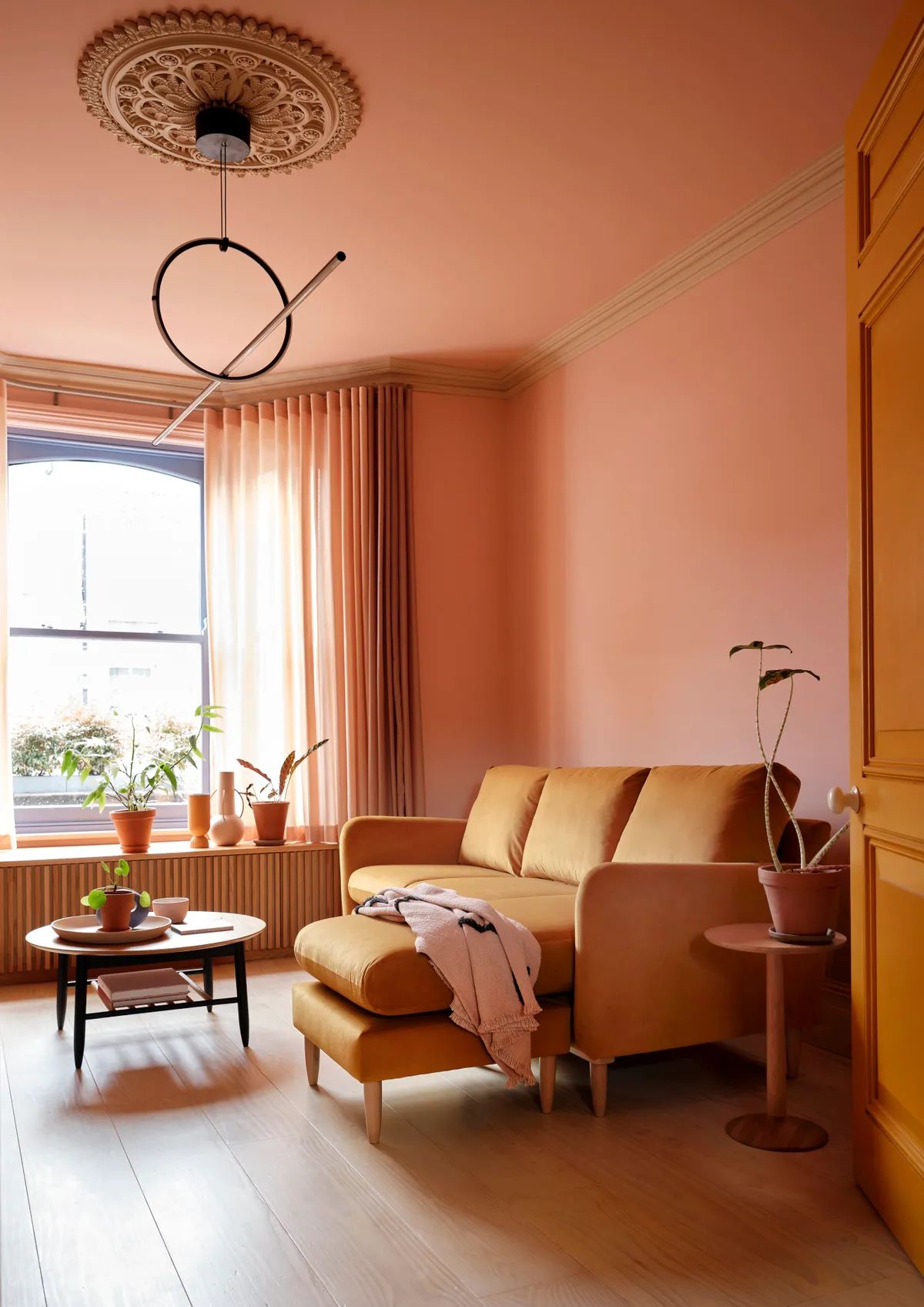
The idea of single colour interiors might give you flashbacks to the 1970s avocado bathroom suites, but when done right, a living room decorated – drenched – in one colour, including skirting, ceilings and all woodwork can be really effective.
In this living room by Ercol, an orange colour palette has been used from the walls and ceilings to the furniture and decorative items. With some minor shade variations and different areas benefiting from different amounts of natural light, this living room looks anything but bland!
Mix and match pattern and colour
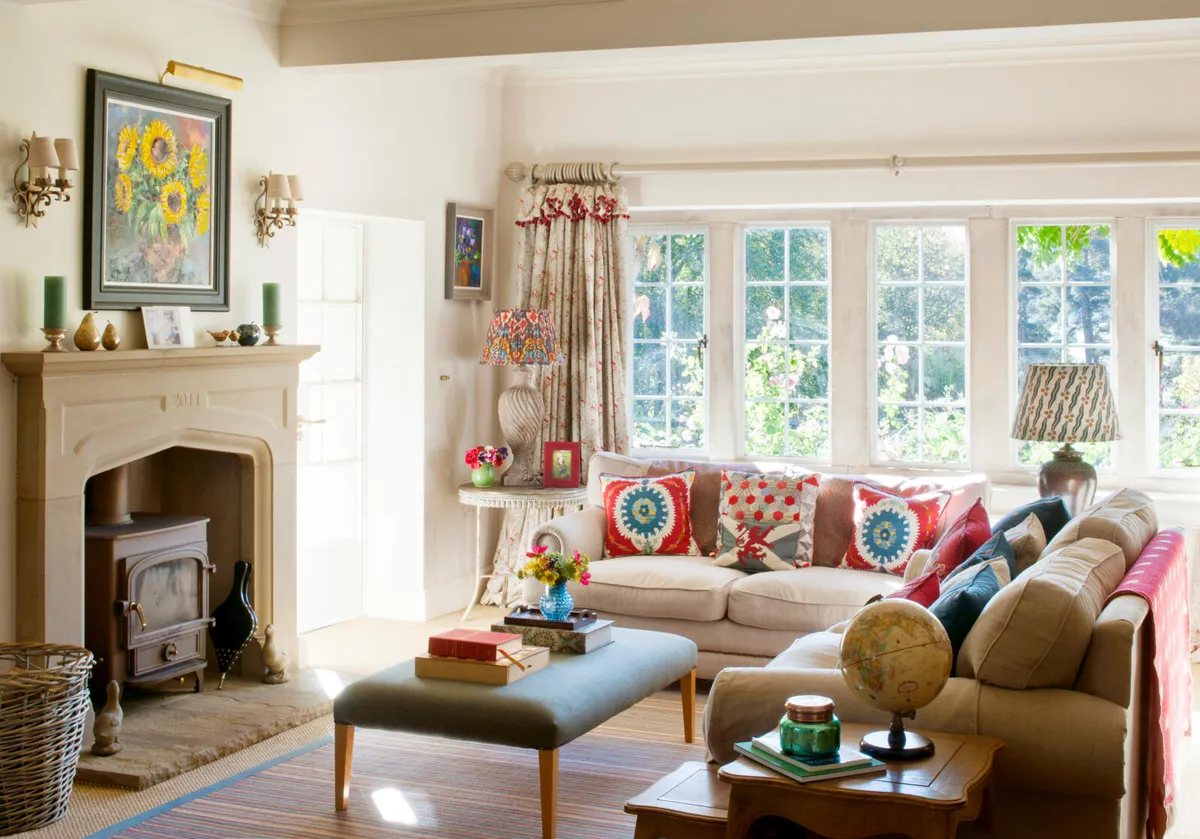
Layering prints and patterns of different sizes and styles is central to classic English country house style. It suggests an interior that has evolved over time – pieces added over the years, brought back from travels or acquired here and then as and when needed.
This sort of look is naturally relaxed and filled with charm, it is not trend-led, but rather the sort of look you can put together as your tastes evolve and change, though nothing is thrown away.
Let the antiques take centre stage
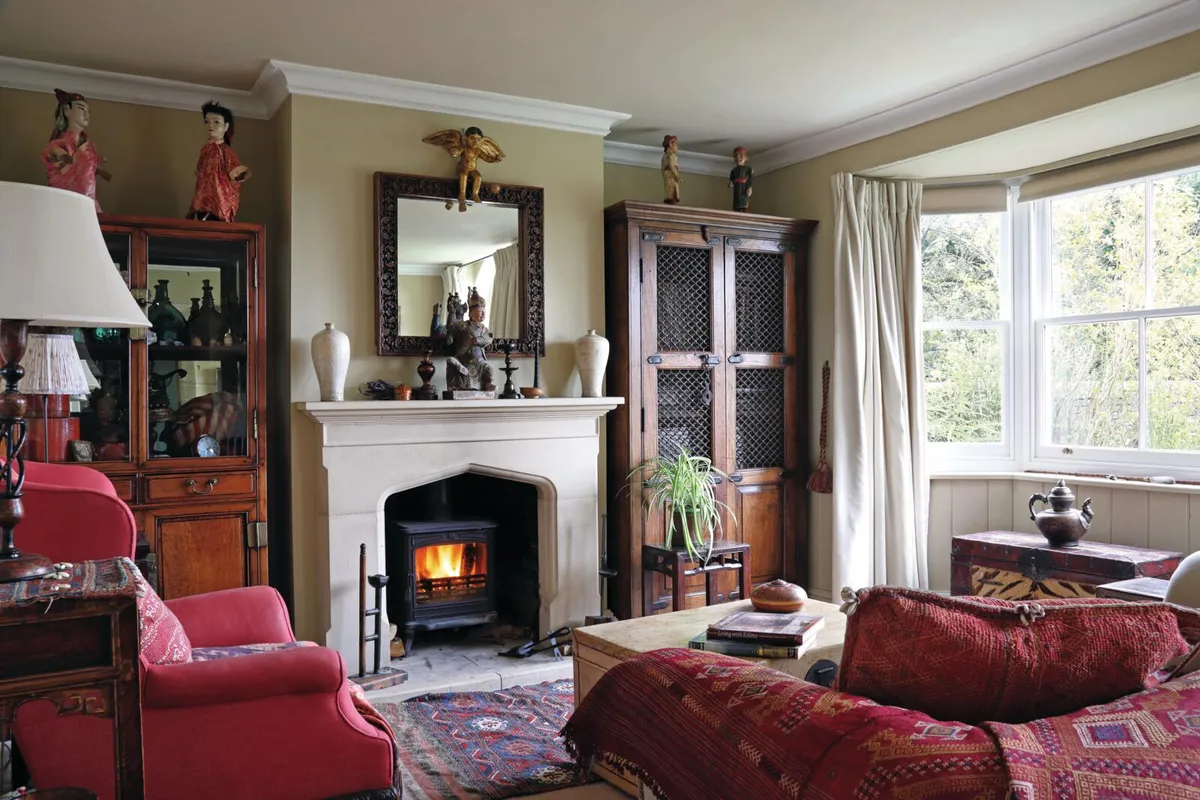
If you are a collector, your antiques will naturally form part of the aesthetic of your home – informing colour choices and the overall style of your furniture
But rather than keeping items in display cabinets, why not set them within the room as interesting focal points, as here, where an ancient statue sits on the mantelpiece with elegant jars on either side, creating a sense of balance and harmony.
Choose curved furniture for a softer space
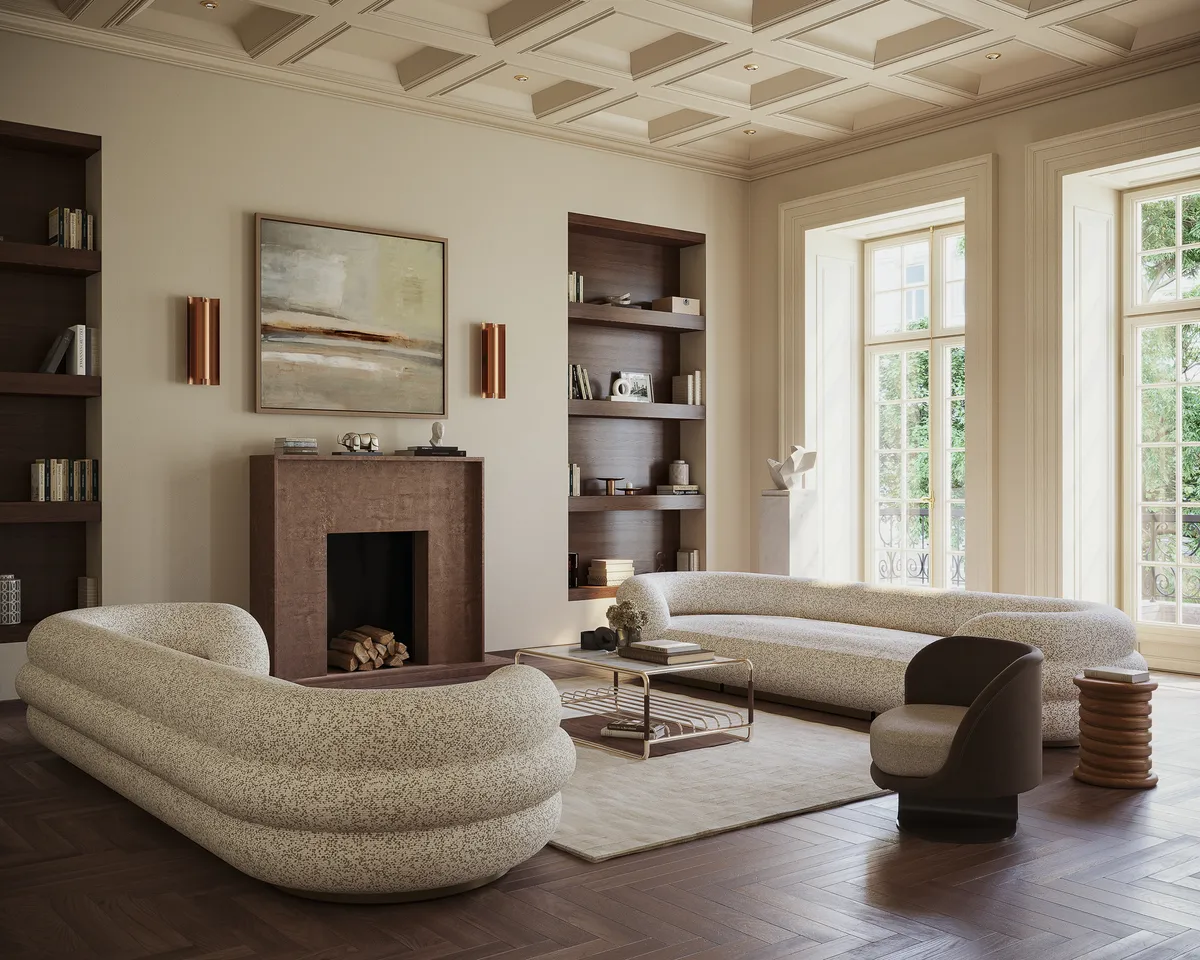
Too many hard lines and sharp corners in a living room can make the space feel cold and clinical.
To avoid this, try introducing curved furniture – rounded sofas have become increasingly popular in recent years as have circular coffee tables, or if you aren't looking to invest in large items, try a round mirror, rug or cushions instead. Here the look is ultra modern and funky, but Deco-style furniture is an excellent choice if you want something that has a more vintage feel.
Create a social space with plenty of seating
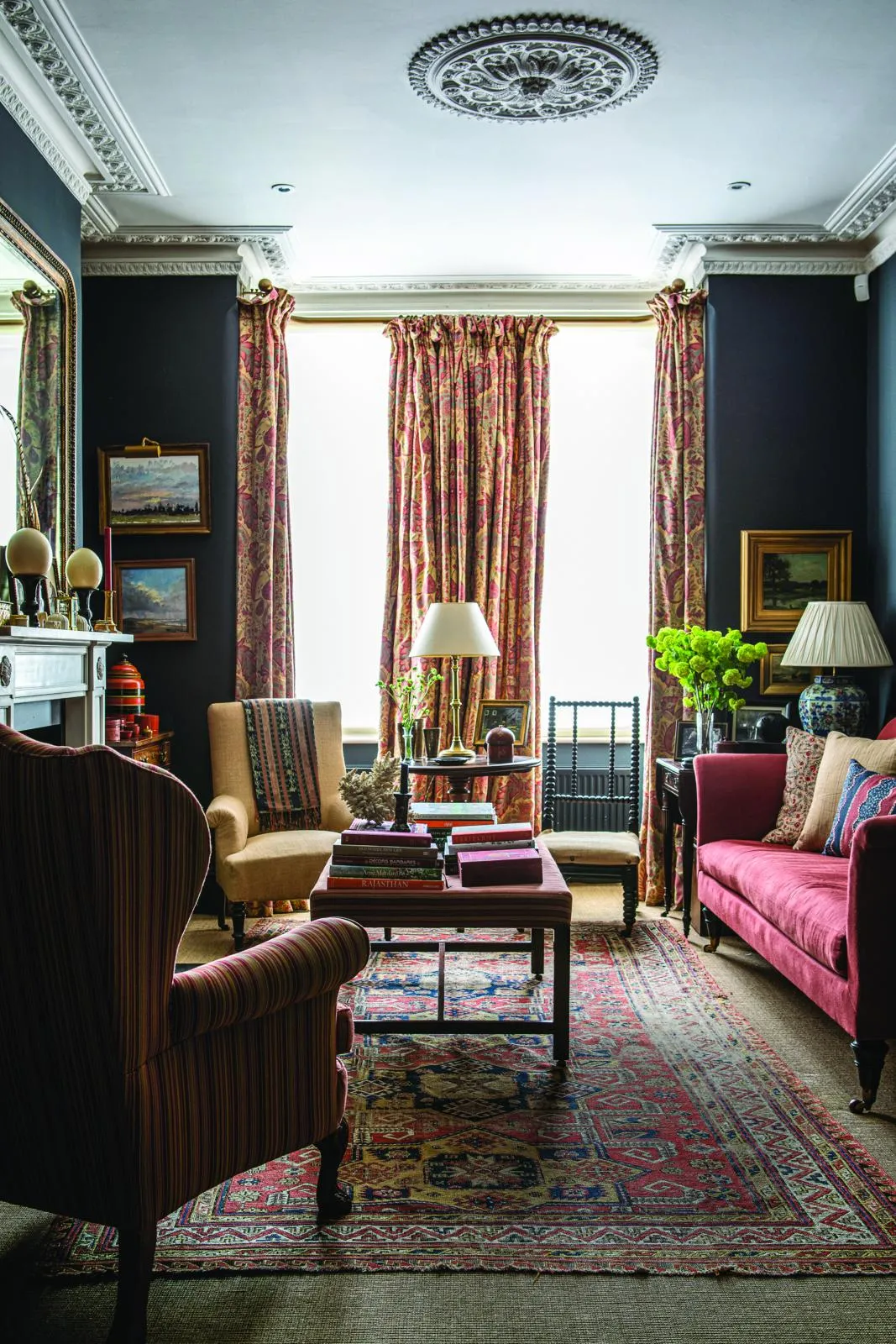
If you're a frequent host of get-togethers, give your living room a club-like feel with plenty of comfortable spots to sit down and socialise in big and smaller groups.
Choose seating, from sofas and arm chairs to smaller chairs, that can be moved around and reconfigured or perhaps even put away when not needed – campaign furniture is an excellent choice if you need flexible, adaptable pieces. This way, you can make sure that the space feels tidy and practical without having to compromise on style.
Opt for a colourful sofa
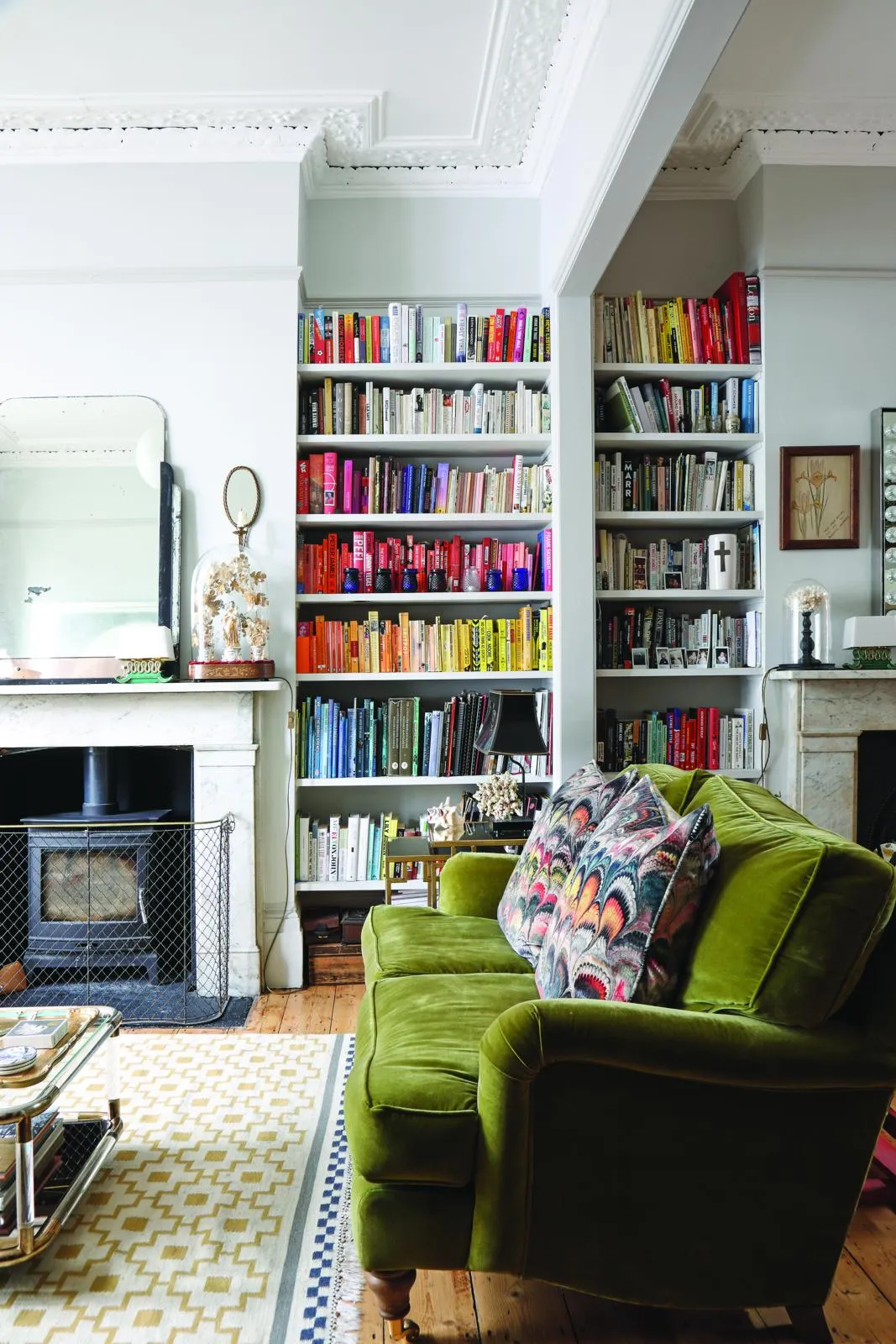
Textiles are an important element of interior design – the fabrics you choose can change the feel of the space, leaning from cosy in spaces such as living rooms and bedrooms, to more utilitarian in kitchens and bathrooms.
In Rose Hanson & Josh Widdicombe's Victorian home, a green velvet sofa takes pride of place in their living room. Set in front of the colour-coded bookcase and period fireplace, softening the white walls and neutral decorative elements.
Add a bookcase to give a library-feel
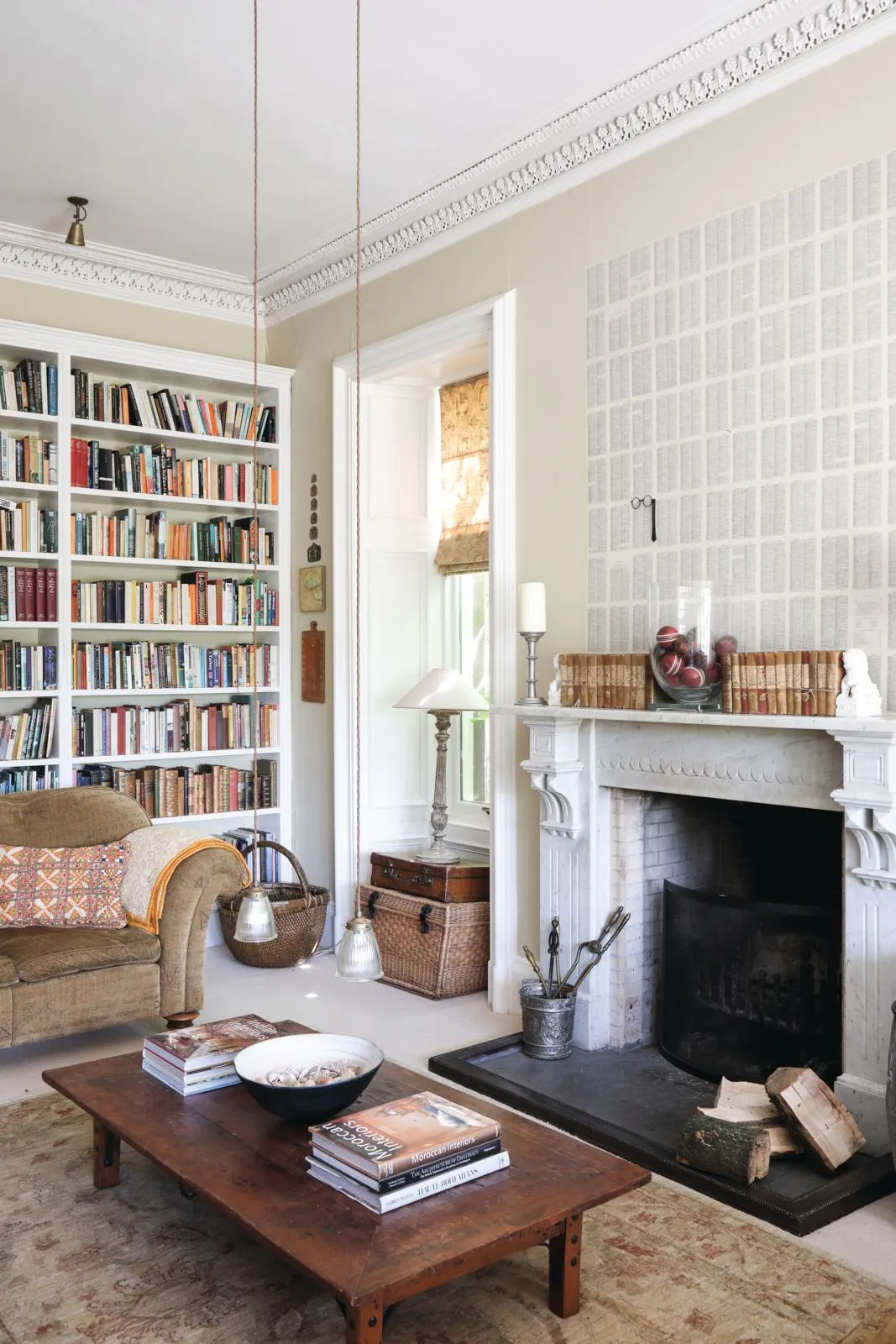
A large bookcase or a set of built-in shelves across an entire wall from floor to ceiling will create an impressive library effect, without dominating the whole room. You can either get creative with the colour-coding of the spines or go for a more relaxed approach with no particular order.
In this home, the books are echoed in a feature wall above the fireplace created using pages from an old book.
Experiment with different fabrics and prints with a shared palette
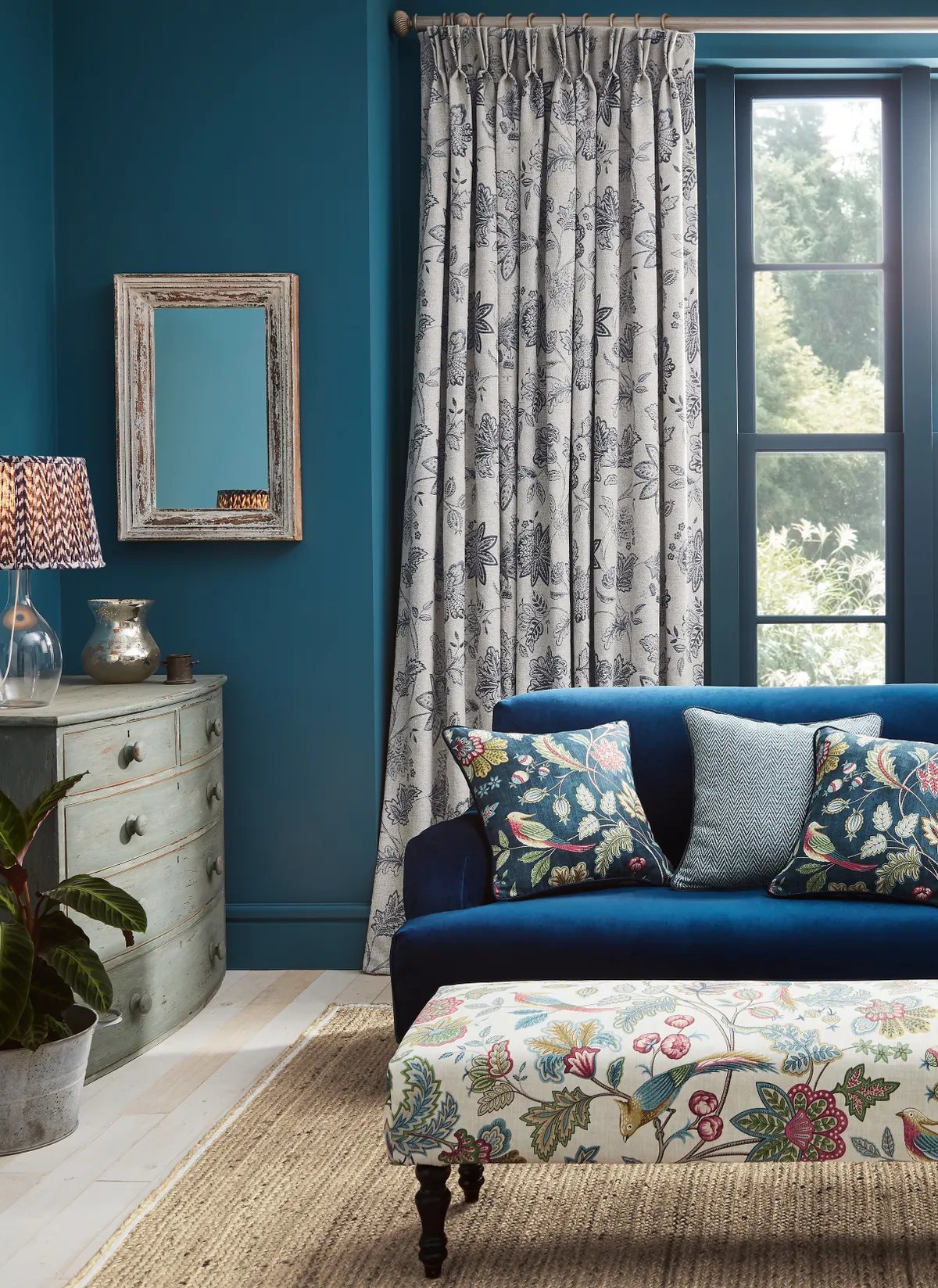
Your living room is a great place to have fun with fabrics and pattern. There's no need to make everything match – think dainty florals on the curtains, and larger floral on a foot stool, and something completely different on the cushions!
If you stick to a single colour palette, as in this living room where blue is the dominant colour, the design will still feel cohesive and as though every element belongs together!
Bring life to a space with house plants
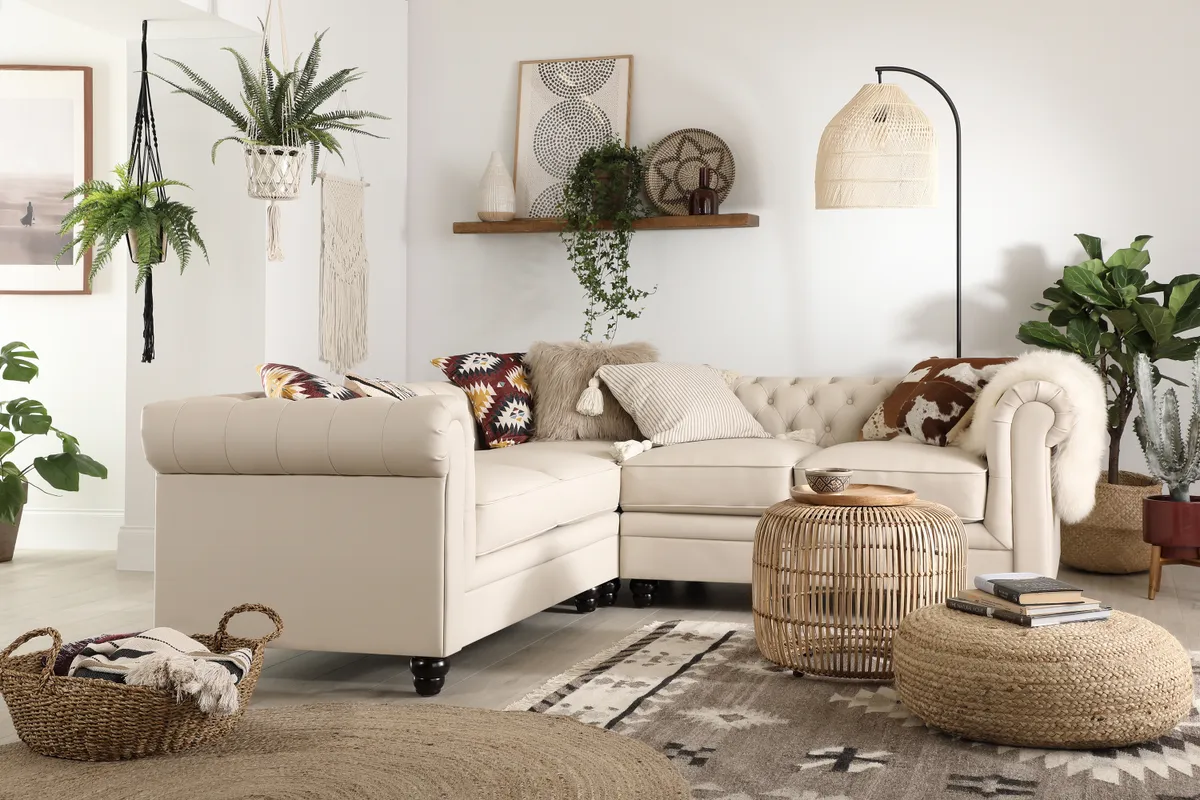
If your living room is feeling a bit flat or boring, you can easily transform it with houseplants. Hang them from the ceiling (we love these macrame-style baskets), pop them on a side table or go for bushy plants and trees to fill an entire corner.
Simply make sure the plants you choose thrive in the lighting that comes into your living room, and if you have pets, make sure the plants aren't poisonous!
Create a gallery wall
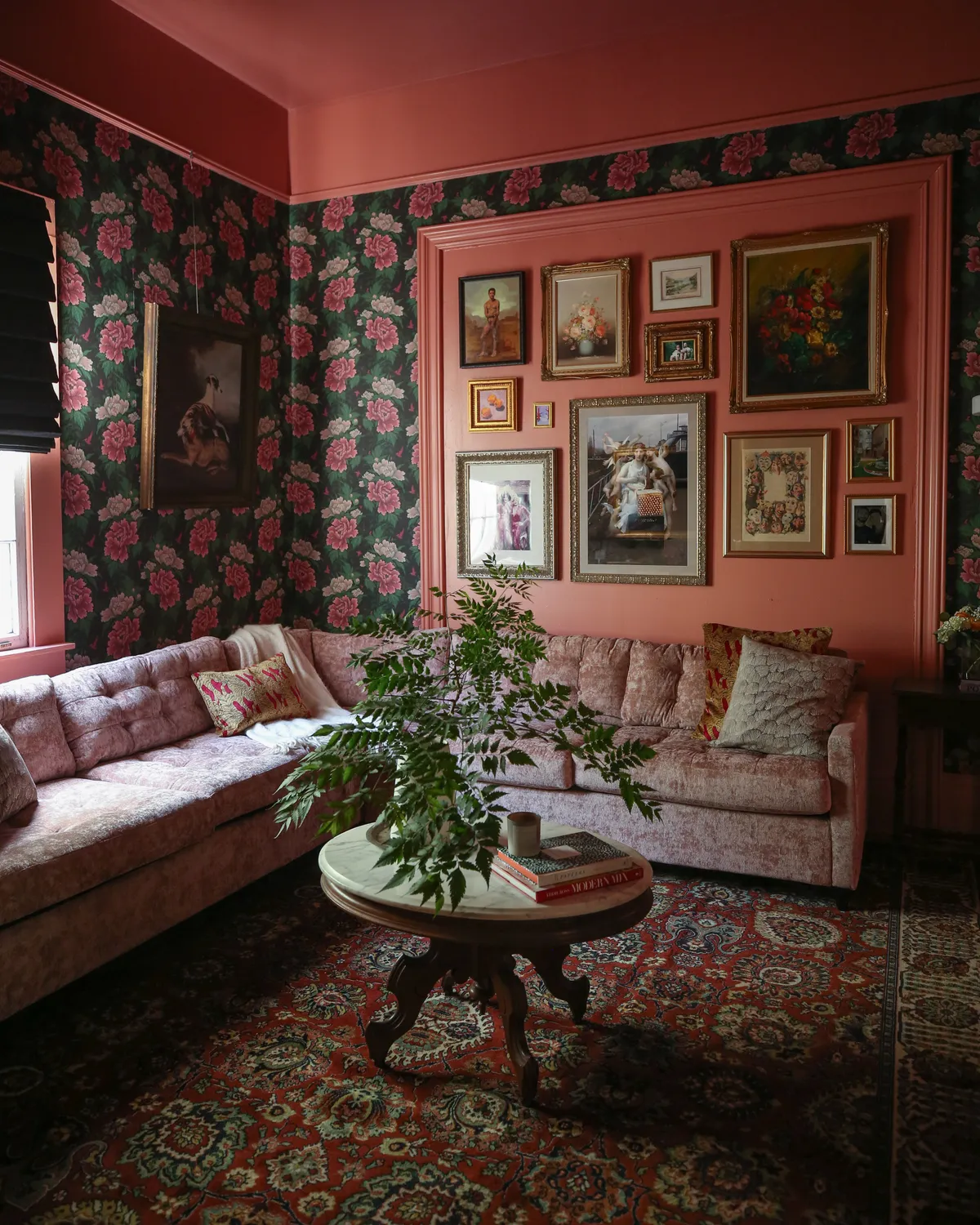
A living room gallery wall is the perfect way to display your favourite photographs and artworks in one space where you will be able to enjoy them often.
Mix and match frame styles and sizes for a more eclectic look (we'd recommend looking for some at your local antiques fairs and vintage shops), or if you're after something more linear, hang the same sized frames in a carefully measured rows.
Make the most of alcoves
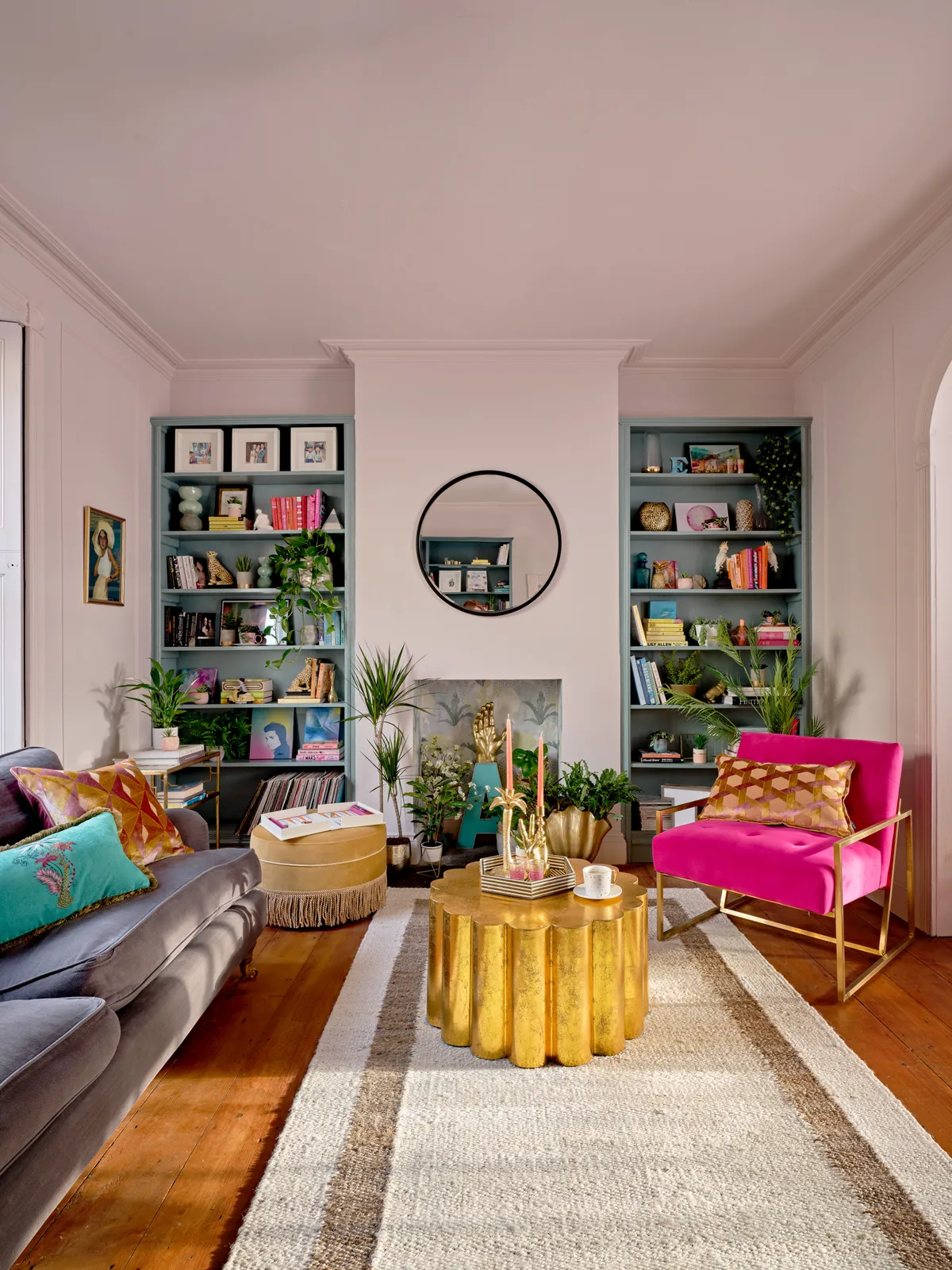
Anyone who lives in a period home probably has alcoves either side of a fireplace or chimney breast. Although at first glance these might feel like a hinderance to your overall design, they are actually really useful.
Living rooms are typically low on storage space, but if you fill your alcoves with a bookcase you will have a practical and visually appealing space to display books, antiques or even a beloved vinyl collection.
Have fun with colour
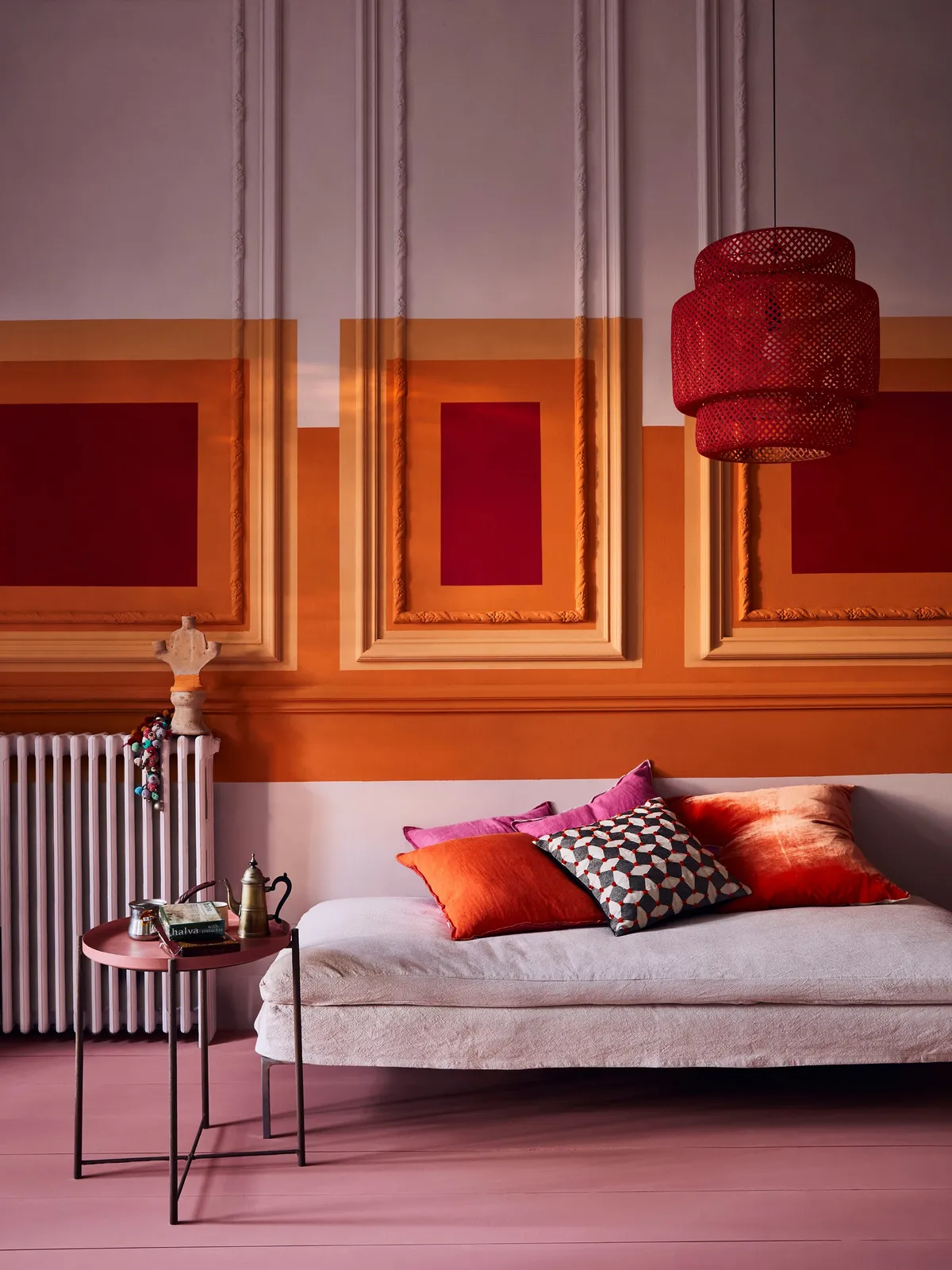
If you're feeling creative, why not turn your wall into a canvas and experiment with colour? In this living room by Annie Sloan, a fun, geometric pattern has been applied to the wall and panelling, creating a truly unique space.
Make a statement with lighting
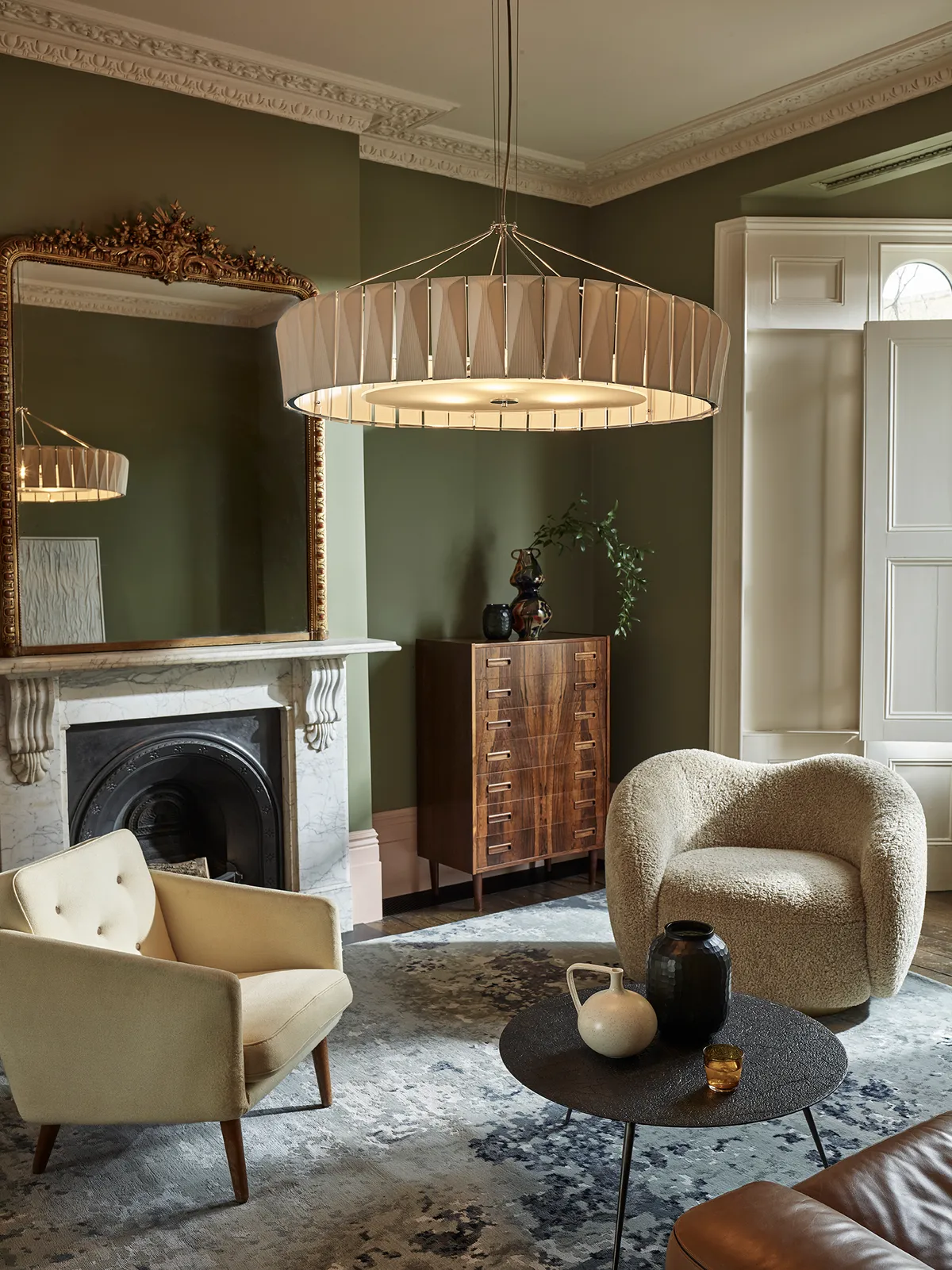
Lighting not only sets the mood for a room, but it can also make or break a space. In the living room, a statement light fitting can be an effective way to centre the space and make the room feel more intimate and cosy.
This chandelier from Original BTC hanging above the seating area, effectively creates a social zone, giving the room a sense of glamour and occasion - perfect for entertaining.
Experiment with trim work
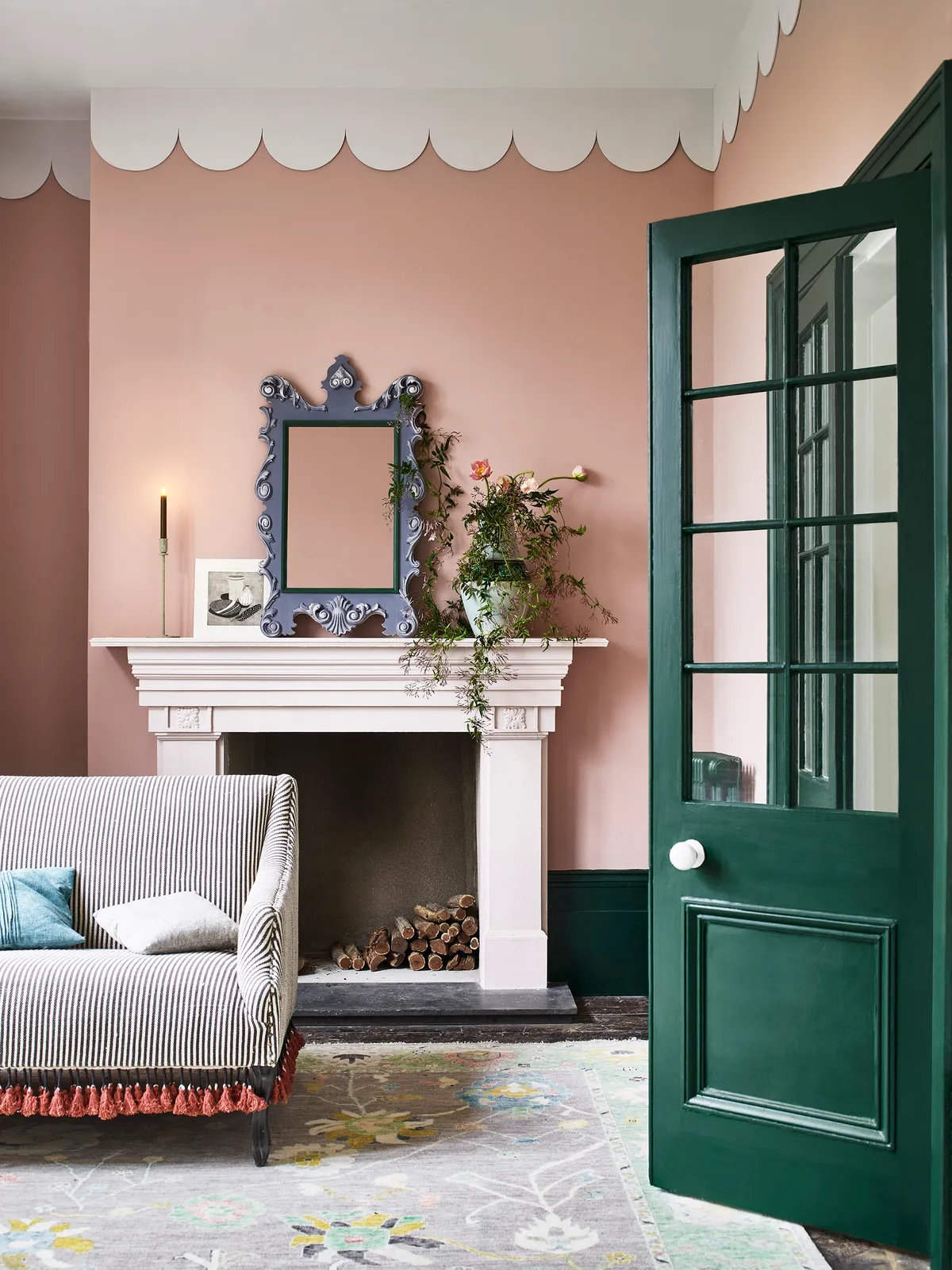
There really are no rules when it comes to decorating your living room, so have fun and get creative with your plans. We love this design by Annie Sloan, featuring Piranesi Pink on the walls, perfectly complimented by the scallop-style trim work added in place of traditional cornicing.
Go bold with colour
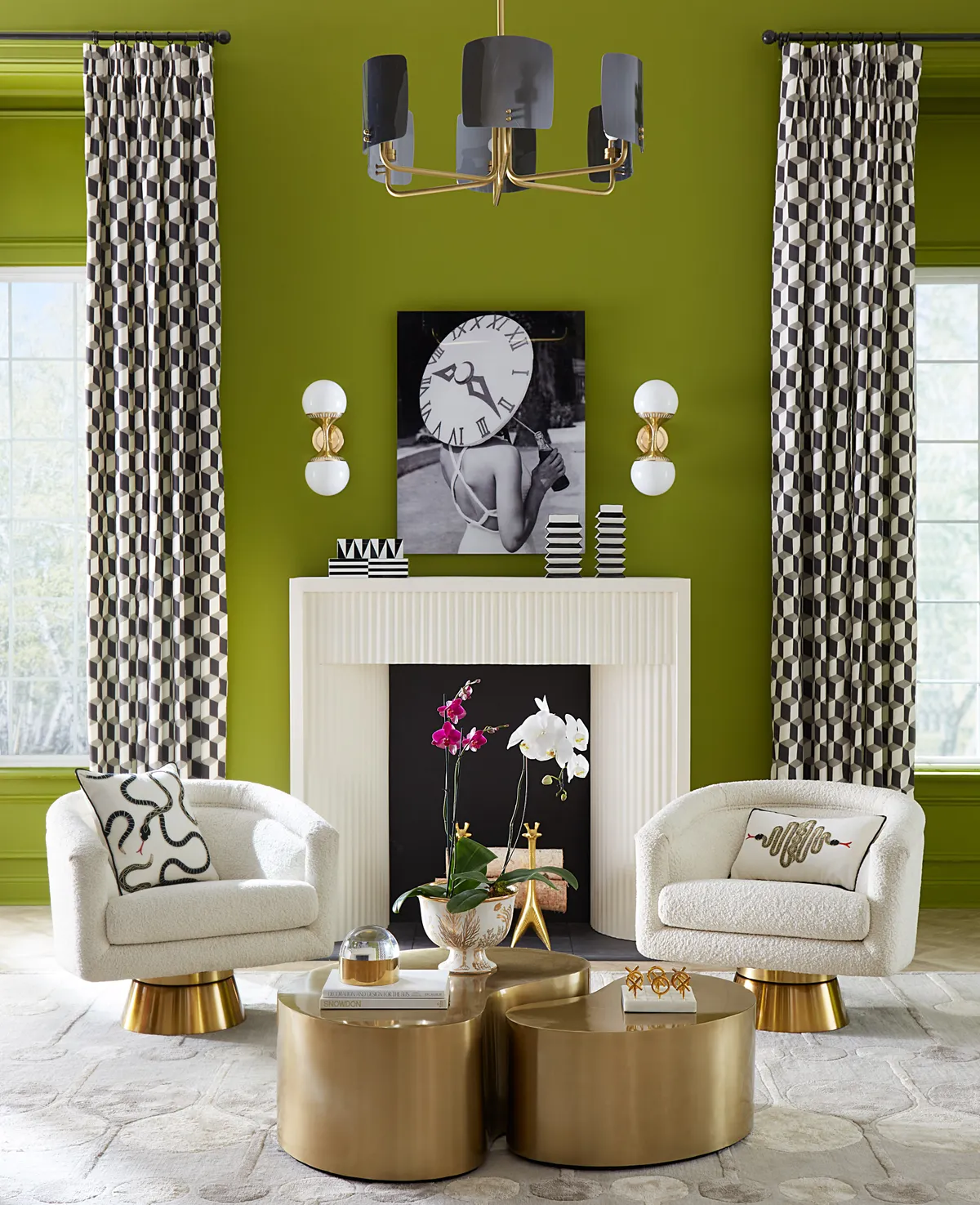
If you're a fan of bold tones, take it to the max with a really vibrant shade. We love this scheme by Jonathan Adler, created using a gorgeous green on the walls and fun, monochrome patterned curtains to contrast. The effect is both chic and fun – the perfect party pad.
Play with scale
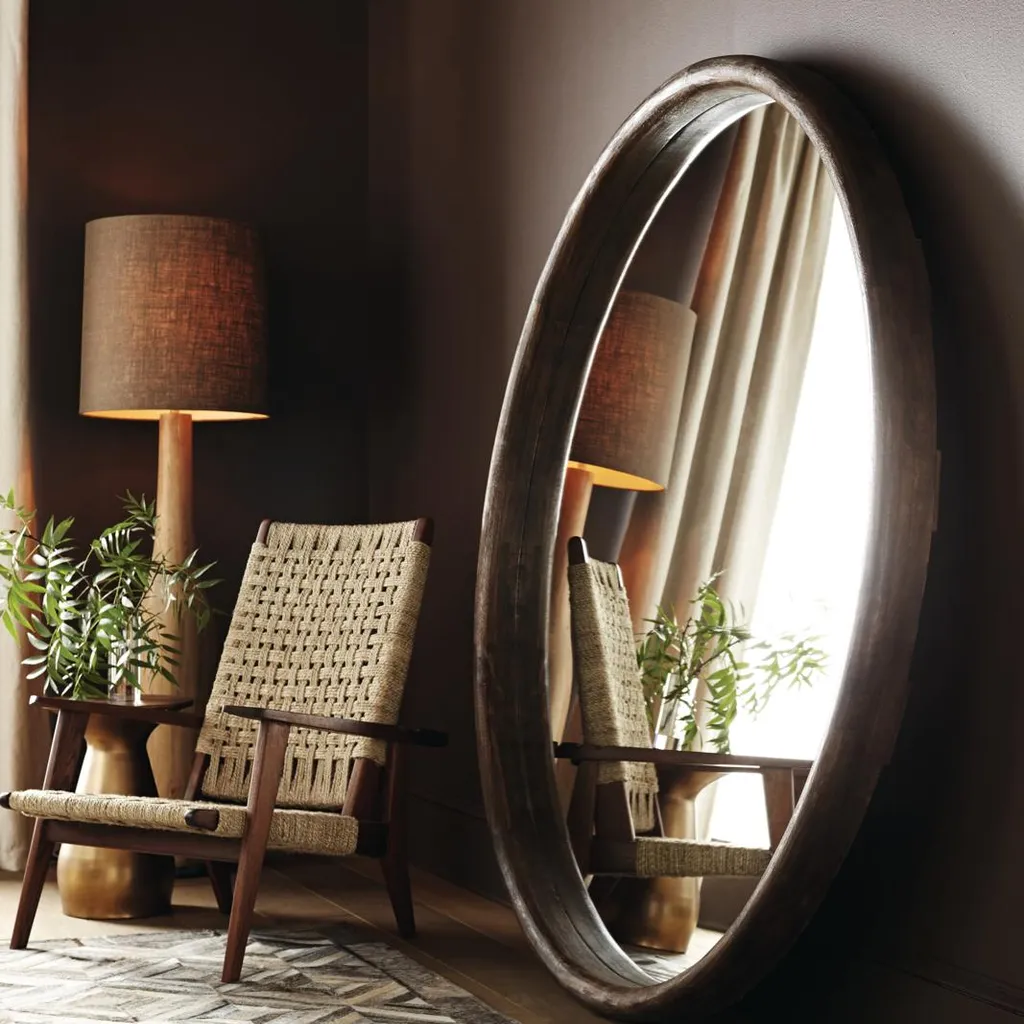
Play with scale and create a focal point with an oversize accessory such as a lamp, vase or, as in this case, a mirror, and team it with furniture that shares a similar aesthetic.
This sleek mid-century-style armchair is a contemporary spin on classic designs such as Bruno Mathsson’s Eva chair and Hans Wegner’s JH512 Folding chair. It is complemented by the simplicity of the circular, wood-framed floor mirror and the retro colour scheme.
Colourful and folksy
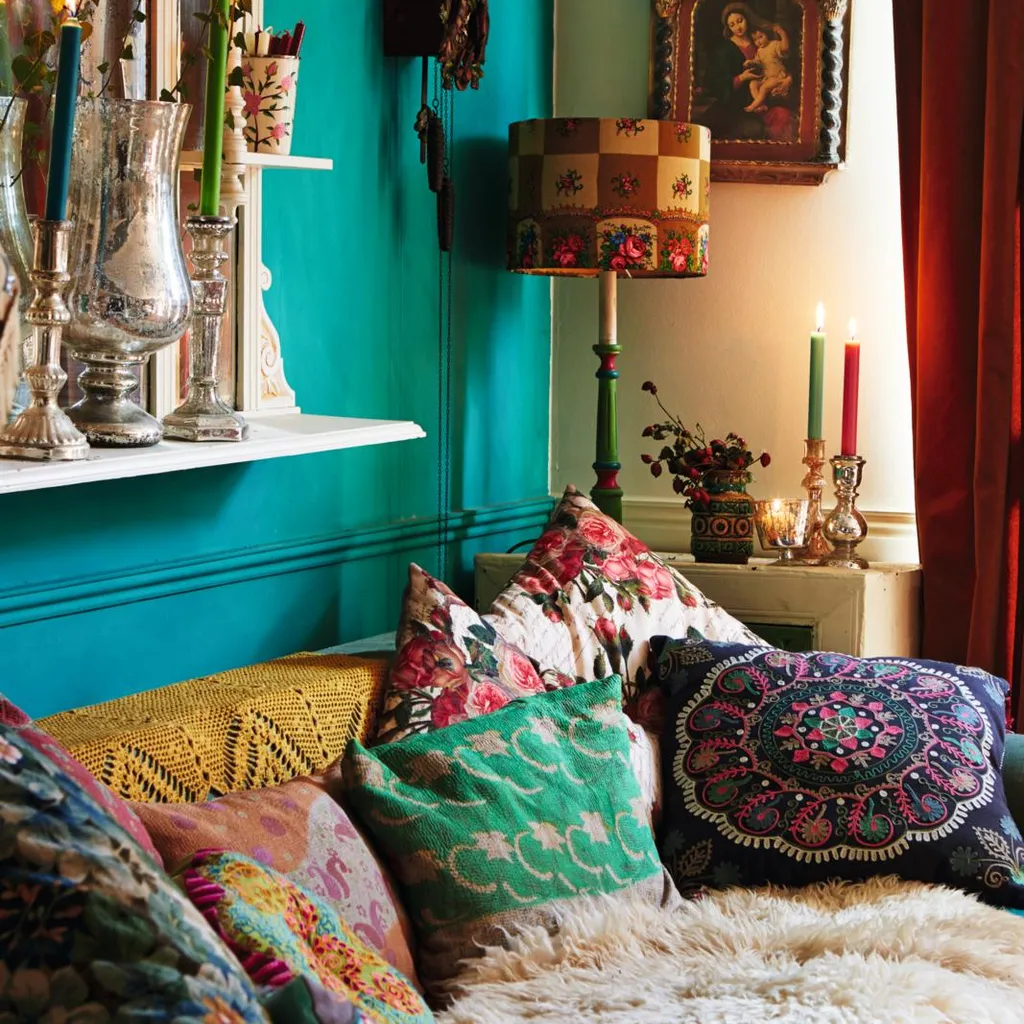
Janice Issit's living room is filled with wonderful jewel bright colours and rich patterns that evoke traditional Eastern European folk art.
Vibrant turquoise walls are the perfect backdrop for her collection of colourful textiles, which she has layered on her sofa for a quirky take on the maximalist aesthetic.
Grey scale
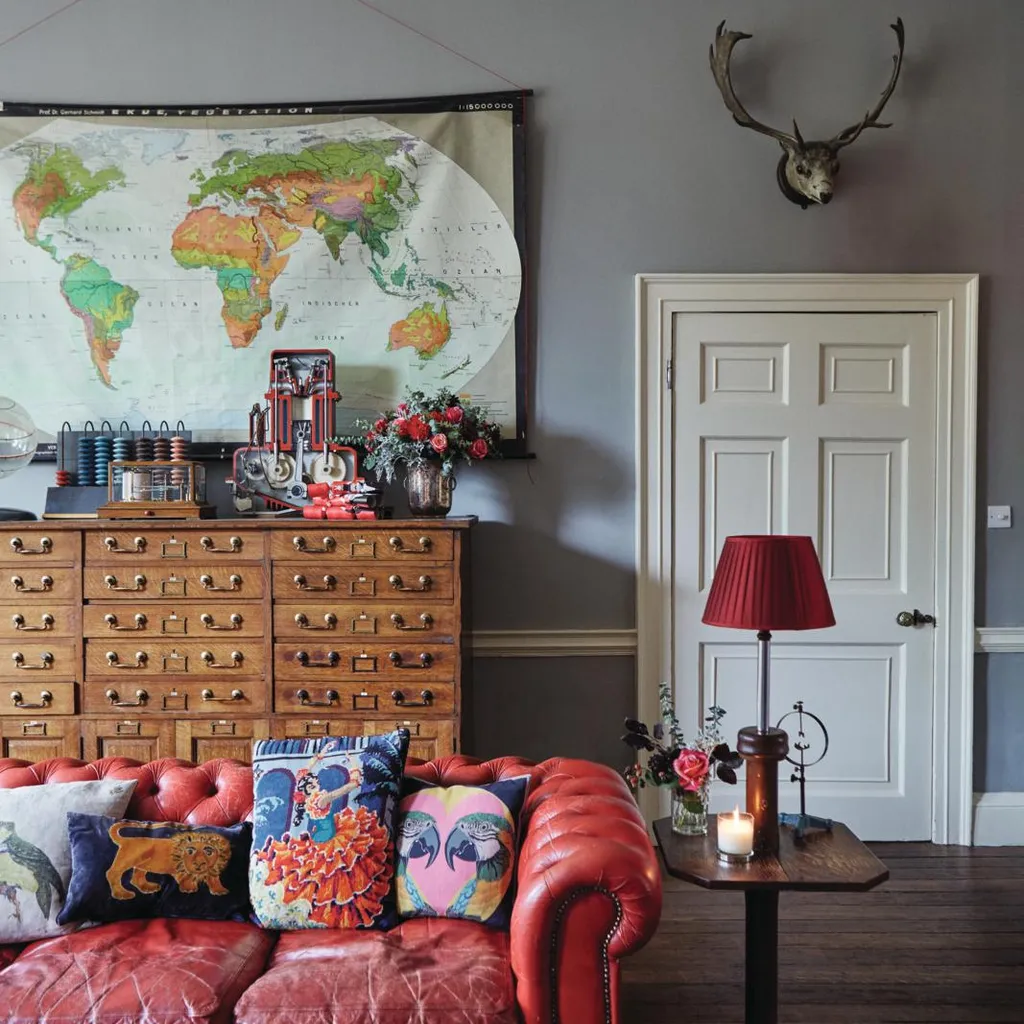
Jim & Chloe Read's house is filled with a wonderful mix of antiques and vintage accessories. The charm of their eclectic approach to collecting and decorating can be seen in their living room.
By opting for a restrained grey and white colour scheme, the couple have ensured that their treasures stand out rather than jostle for attention, from the Eastern European educational props to the vintage needlepoint cushions that fill the sofa, every piece has its chance to shine.
Classic restraint
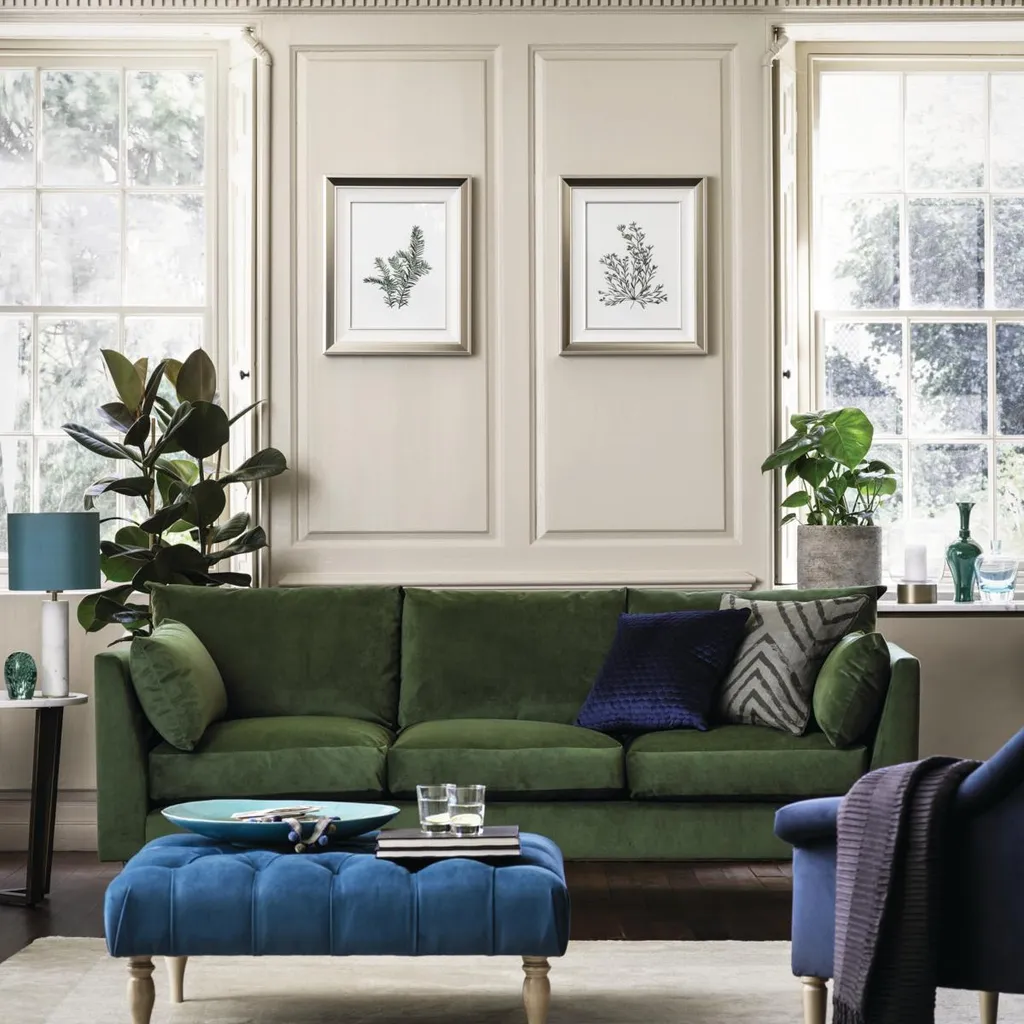
The simple elegance of wood-panelled walls is hard to beat. If you’re lucky enough to have original panels in your home, make the most of them by keeping furnishings pared back and minimal. However, reproduction panelling is easy to install and will add sophistication to any room.
Texture and contrast
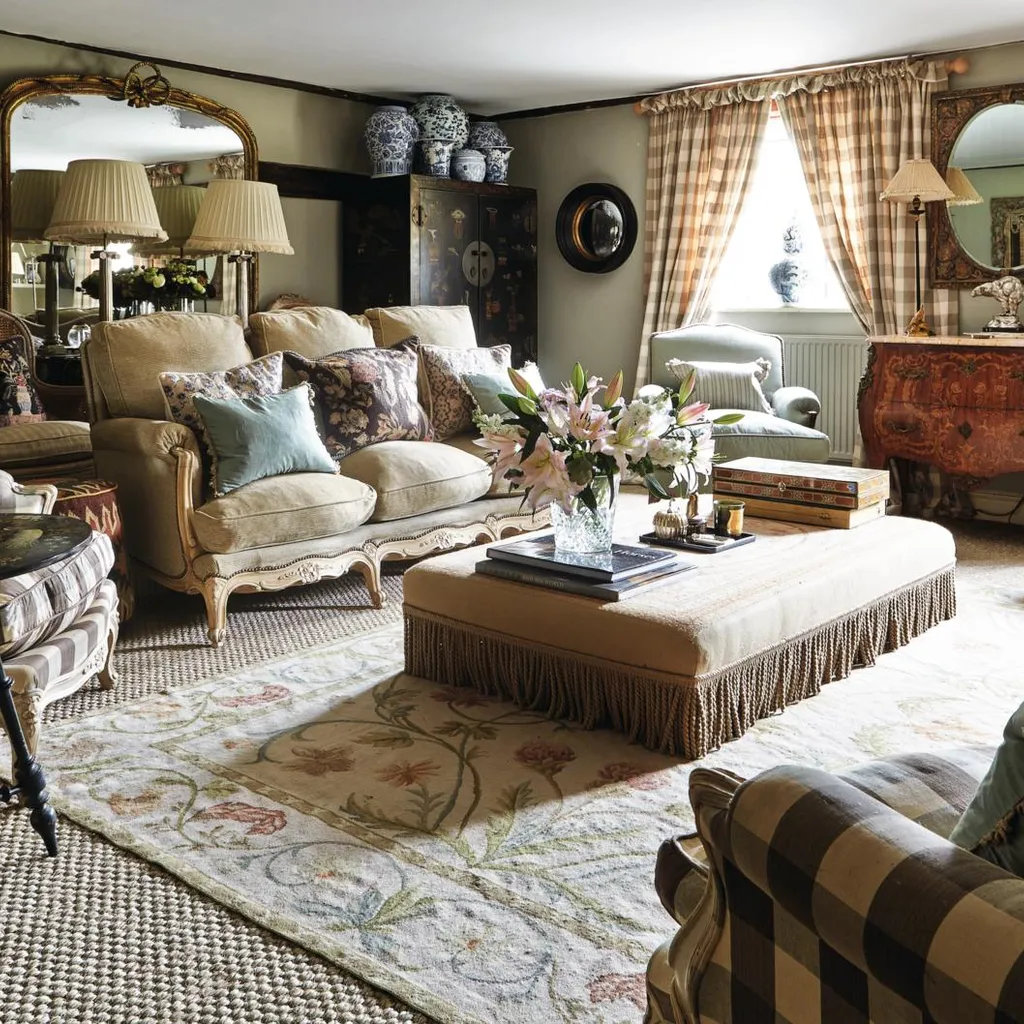
The key to the appeal of this traditional scheme lies in its contrasts. The formal, symmetrical arrangement of the antique furniture and accessories is softened by the textiles: bold checks, slub linens and raw silks are layered with pretty chintzes and luxurious trims for added interest and a subtle sense of luxury.
Play and display
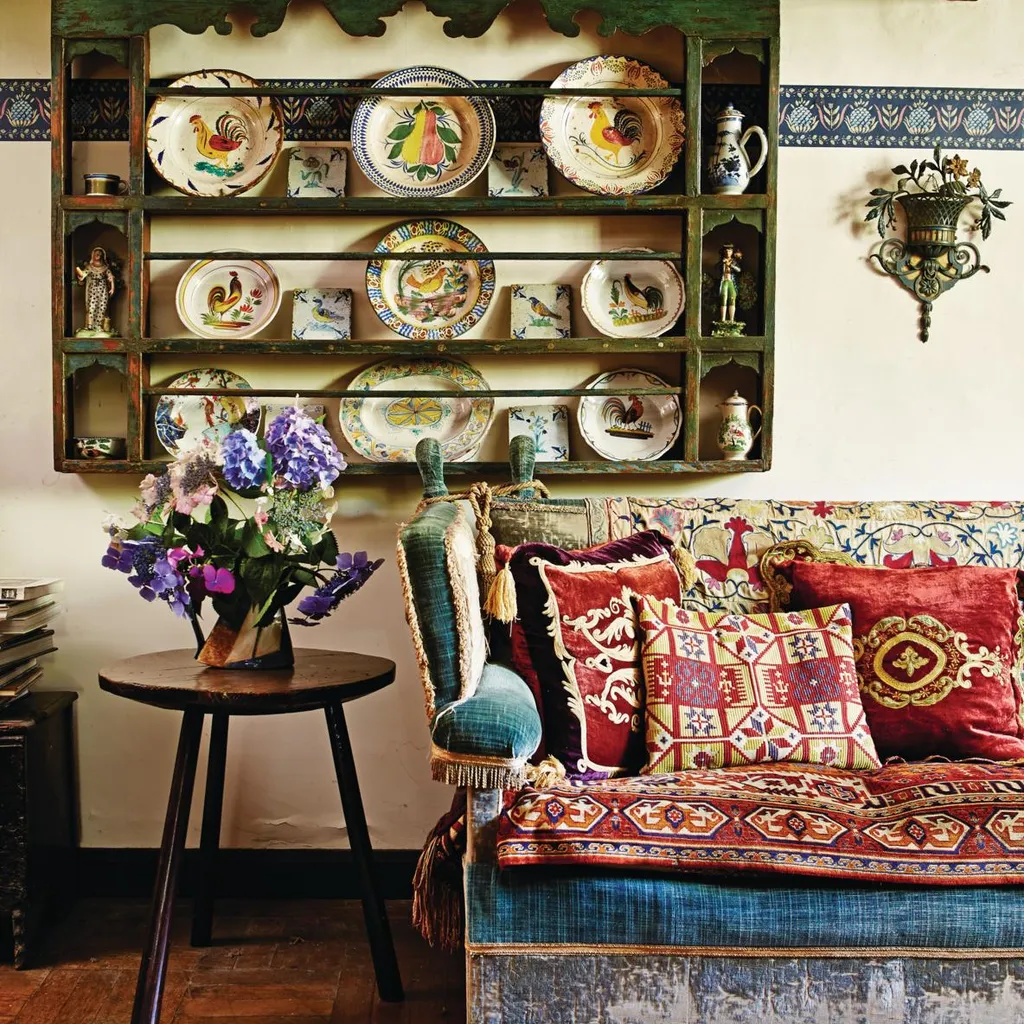
Helen Linfield's house is full of brilliant ideas, from her clever use of colour through to her lateral thinking when it comes to display.
Though you might typically find a plate rack in the kitchen, Helen has made it a lovely feature in her living room, where it is used for displaying antique ceramics that are perhaps a little too good to be used day-to-day, but which are nice to have on hand for special occasions.
You can experiment with different ways of displaying ceramics like this: try overlapping and layering contrasting pieces for a more relaxed effect or if you want to make more of a statement leave it sparse, with only one or two platters. Alternatively, fill up gaps with trailing plants, collectable figures and other curios.
People please
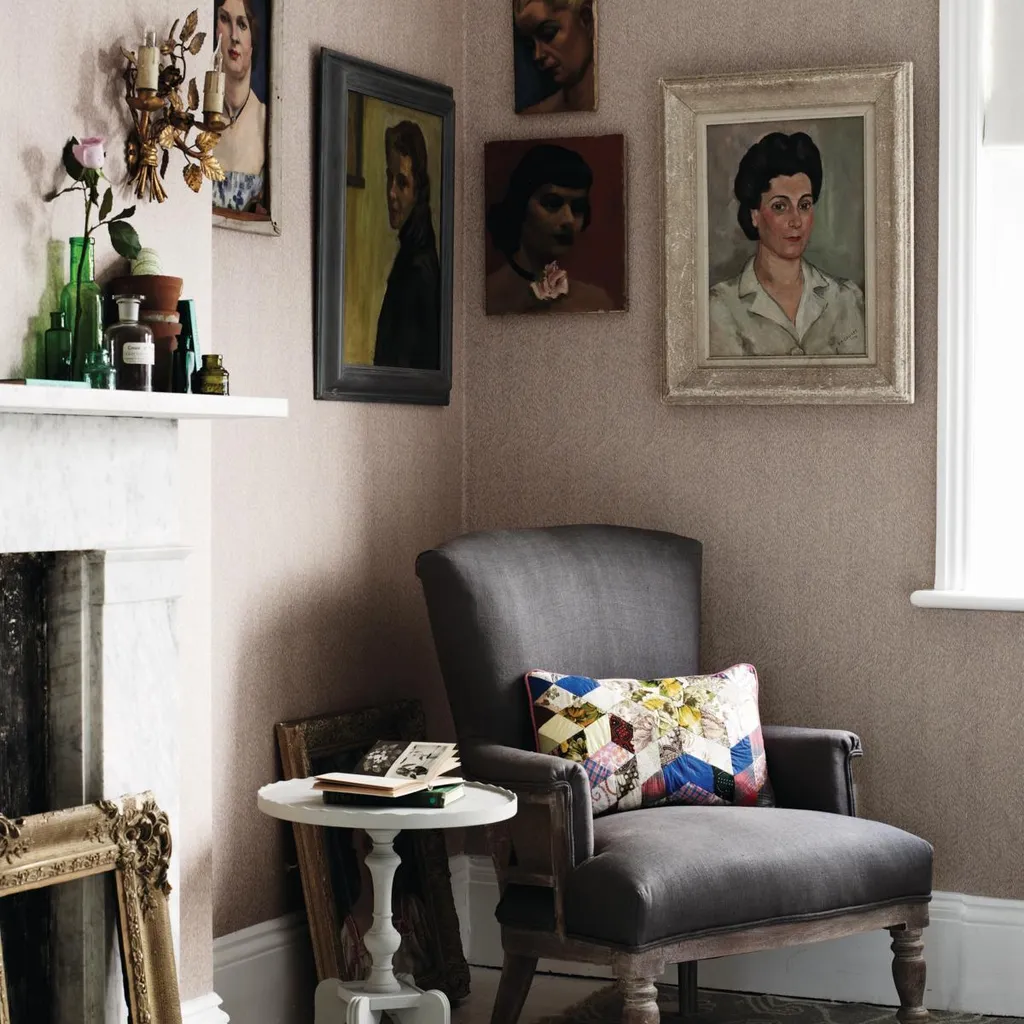
Antique portraits are a lovely way to add interest to your living room walls. They can easily be bought at auction or at flea markets, and offer a sense of nostalgic, romantic mystery when one is unsure who the subject might be.
Paintings of different sizes, colours and styles often work best together – especially when hung at random to make a virtue of their differences. It's a sure-fire way to bring personality to your living room.
Perfect symmetry
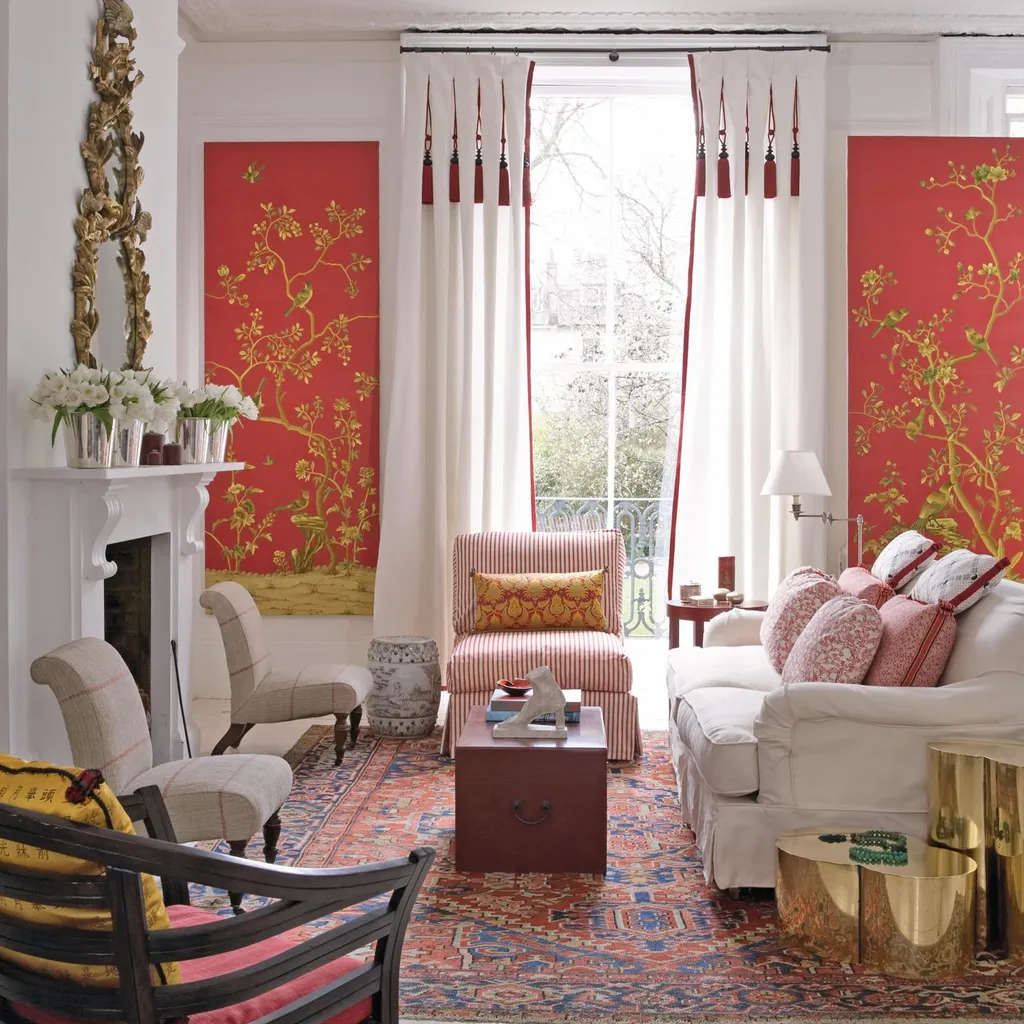
These framed Oriental wall hangings lend a sense of gravitas to this traditional living room scheme.
As a pair, they flank an impressive full length sash window, and the red-trimmed cushions and curtains help to round-off the look. Instead of bespoke hangings, you could also frame wallpaper fragments or antique textile for a similar effect.
Green scene
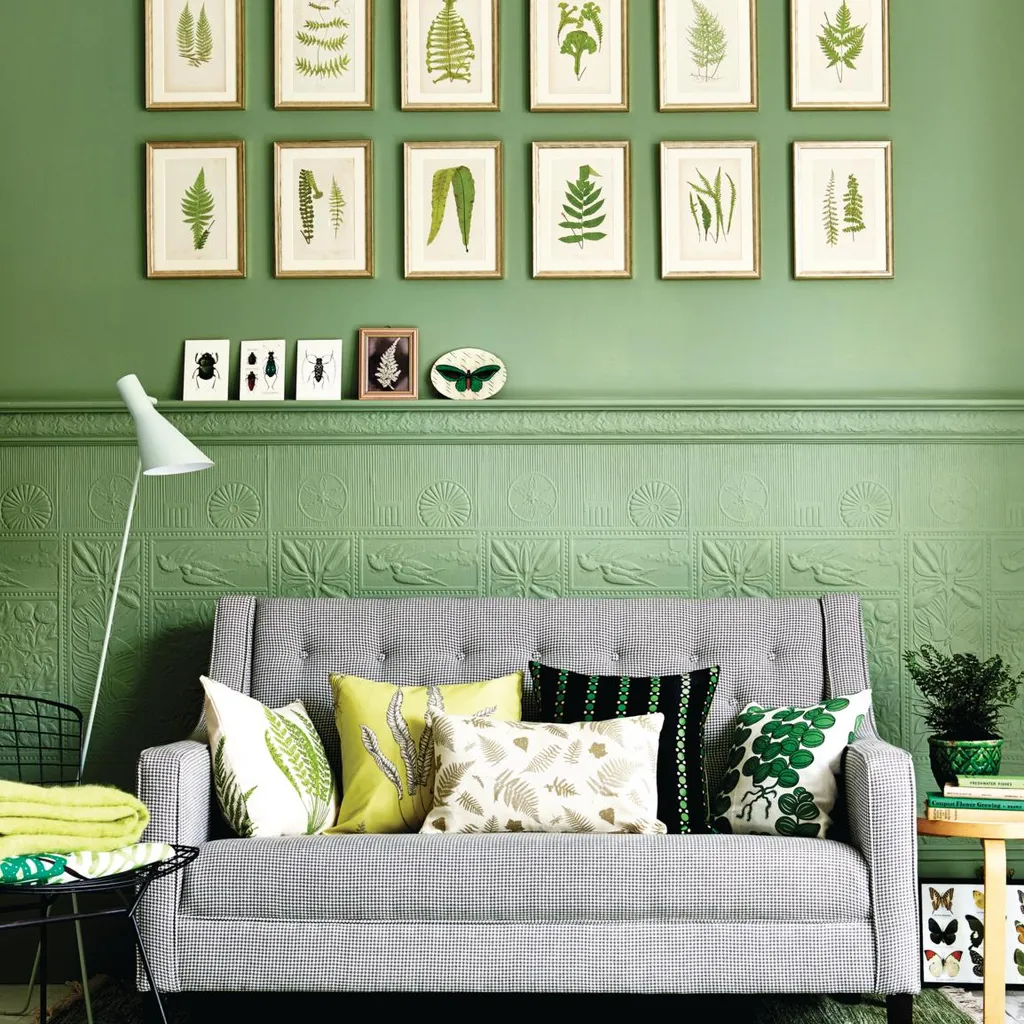
Ferns were popular among the Victorians, so sketches, pressings and prints of the leafy fronds were highly sought-after. This wonderful display of c1870s designs in matching brass frames looks neat and refined, especially with the living room wall behind painted in a similar verdant tone. A vintage sofa in smart houndstooth print give the scheme a fresh spin.
Global zoning
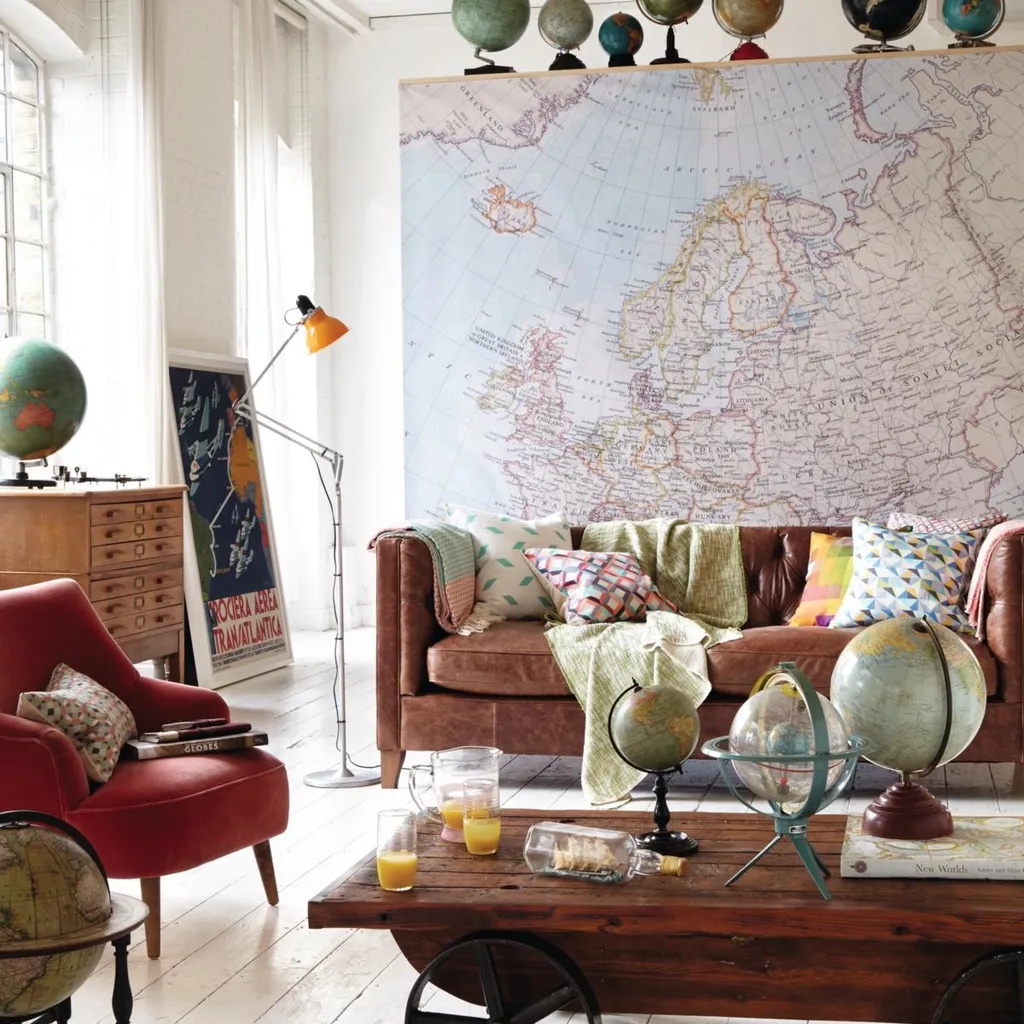
For particularly large living rooms, dividing up the space using a screen or stud wall can help to create nooks and living 'zones'.
In this large loft-style space a room divider which has cubby holes on one side and a flat back on the other, provides space for a vast map of the world as well as a useful ledge on which to display curios such as these colourful antique globes.
Flower power
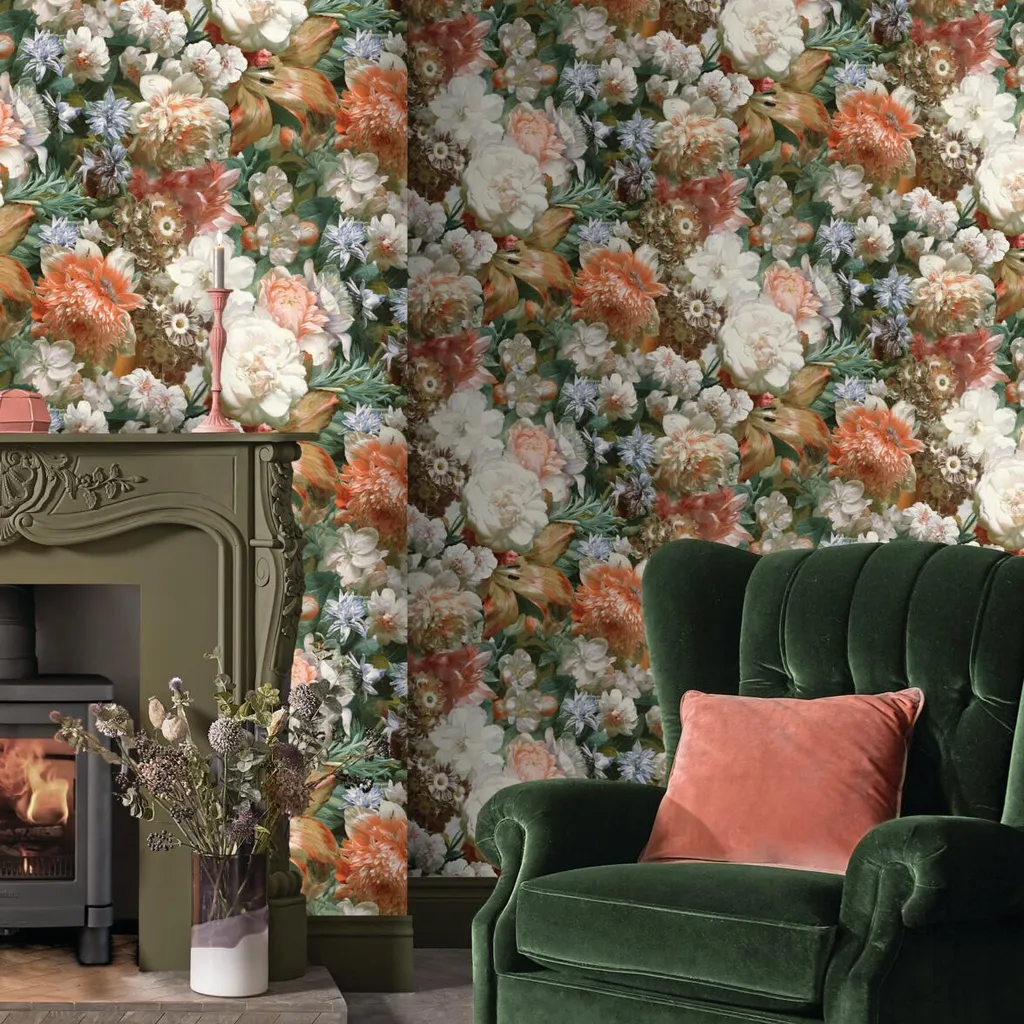
Big, bold florals are a love of loathe choice, but whatever you feel about them there's no denying they do make an impact. Choose accent colours that echo the details in the design to ensure the look is cohesive rather than overpowering.
Make art the star
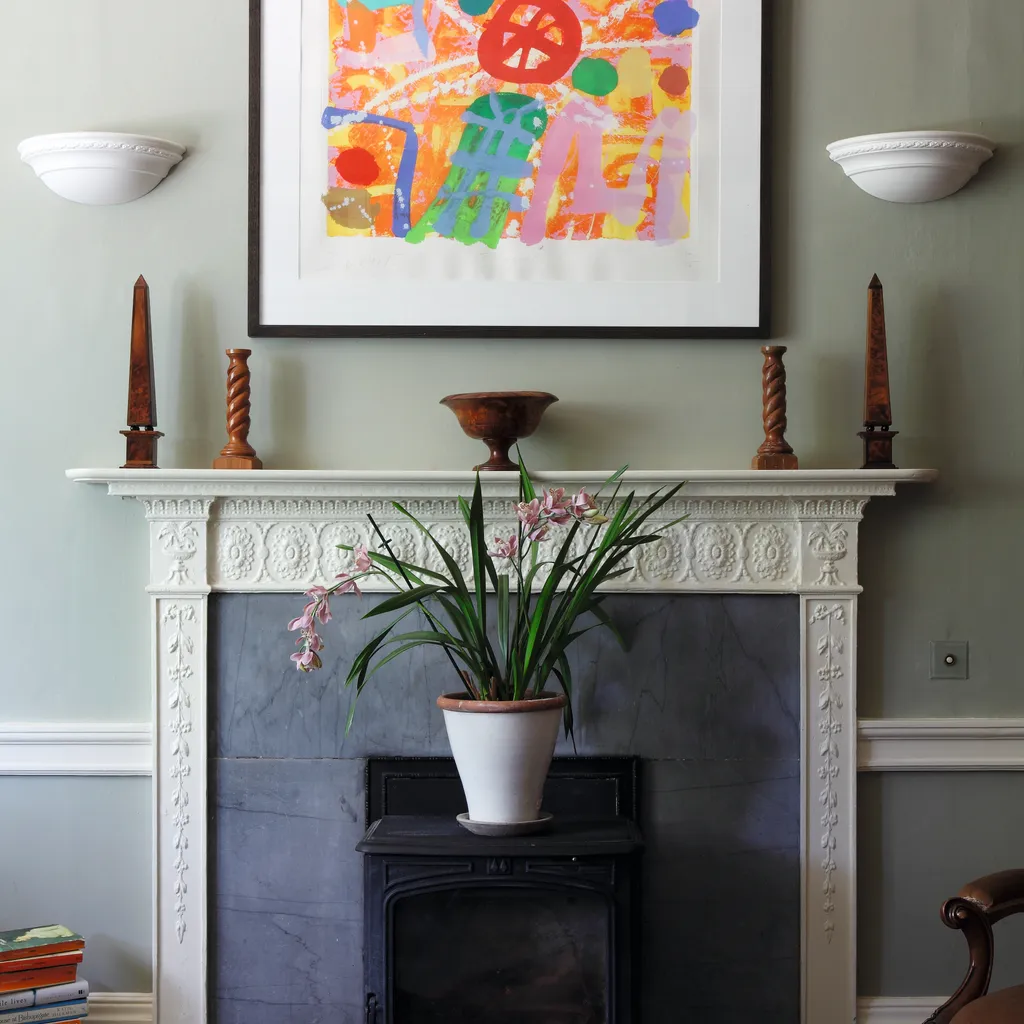
A wonderful original print is not only an uplifting addition to your living room, but it can provide a unique and unusual focal point above a mantelpiece, a brilliant alternative to a mirror.
Here a simple arrangement of classic turned wood obelisks, candlesticks and a pedestal bowl provide a nice classic contrast to the joyful modern print above. A calm and restrained palette of neutral greenish grey on the walls holds it all together.
Panel show
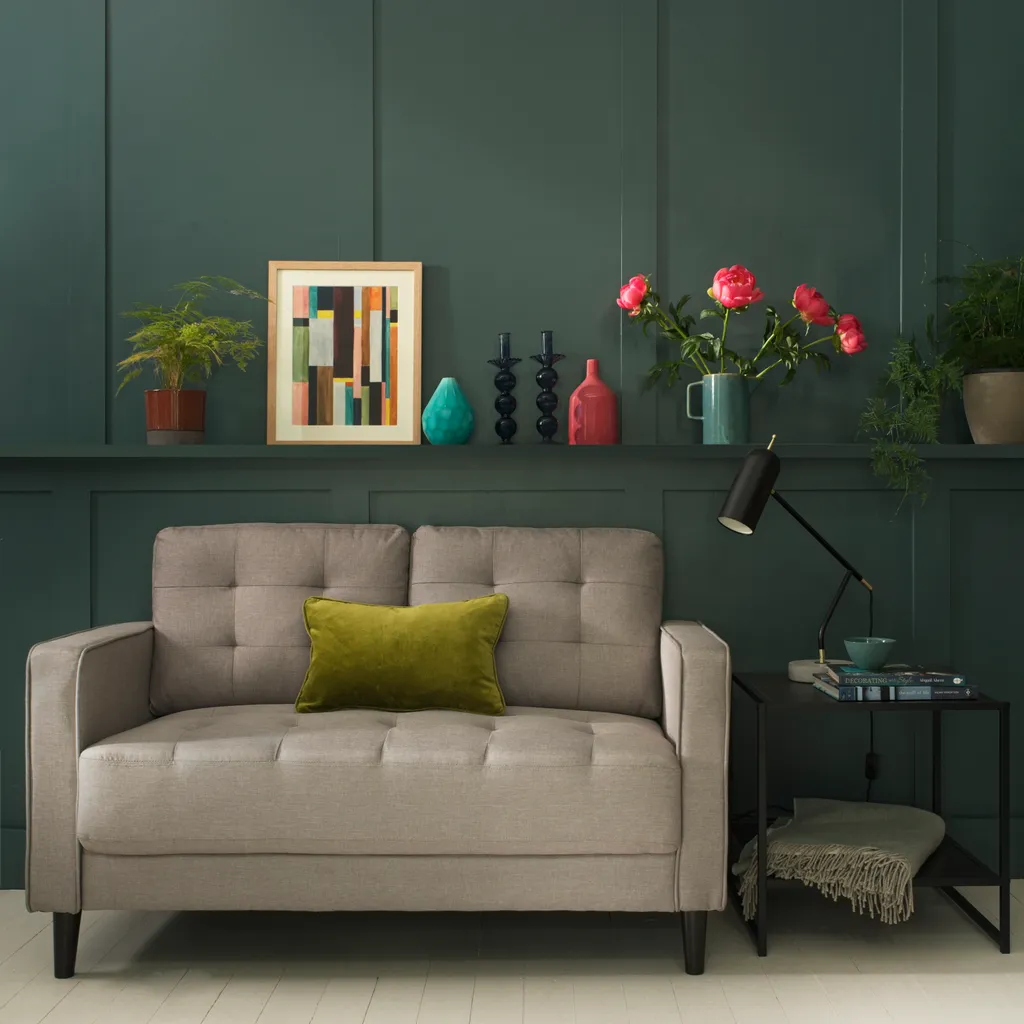
Integrating a low shelf at the height of dado rail when designing and installing panelling will offer opportunity for visual interest in the form of small arrangements that can be changed around and swapped out as the mood takes you.
This simple trick will allow you to freshen up a scheme without having to go all out and redecorate. The linear shelf ensures that the room feels balanced by cutting across the oblong panels.
Experiment with bold colours
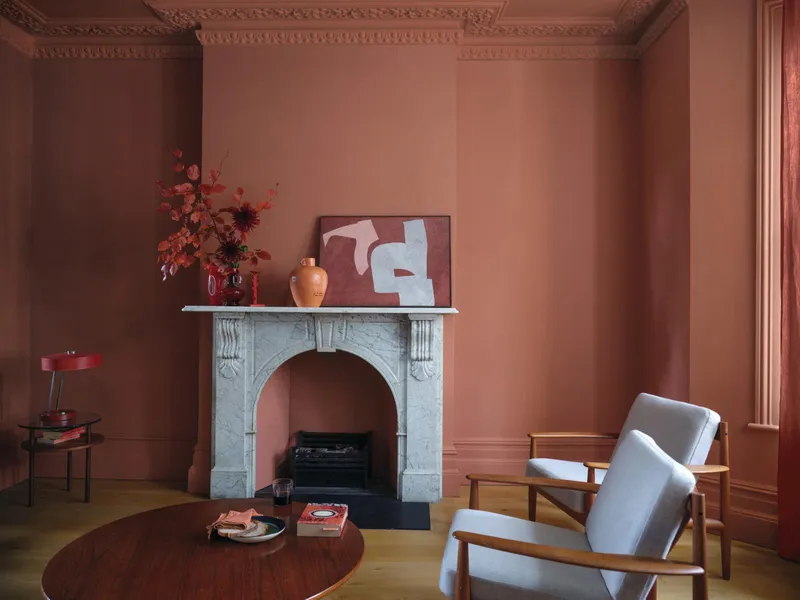
Joa Studholme, colour curator at Farrow & Ball, believes we’re becoming more adventurous with colour and cites earthy tones as a good starting point for autumn schemes. ‘Try warm neutrals like Stirabout and Jitney, paired with rusty reds like Red Earth,’ which is seen here.
Consider distemper paint
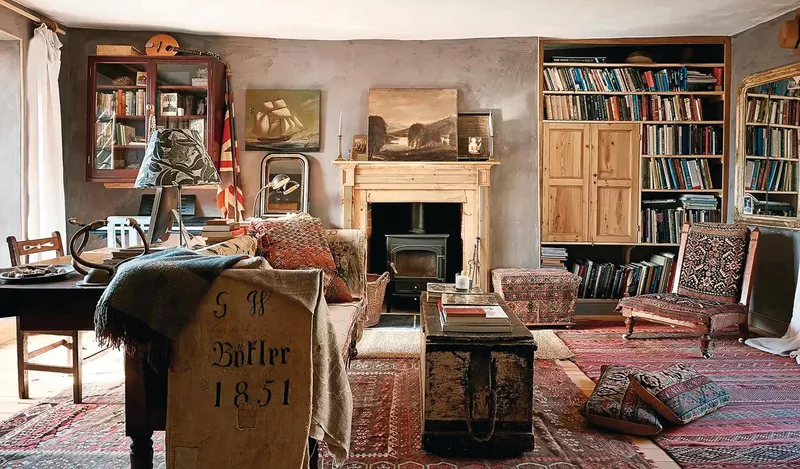
‘The limewash look remains popular,’ says Tom Balch, director of Rose of Jericho. ‘It gives a lovely subtle texture, but is often inappropriately specified for painting over modern paints. Distemper is a great alternative – seen here in Egyptian Grey – for a similarly tonal, matt look that’s easier to apply over a variety of substrates.’
Overhaul your living room
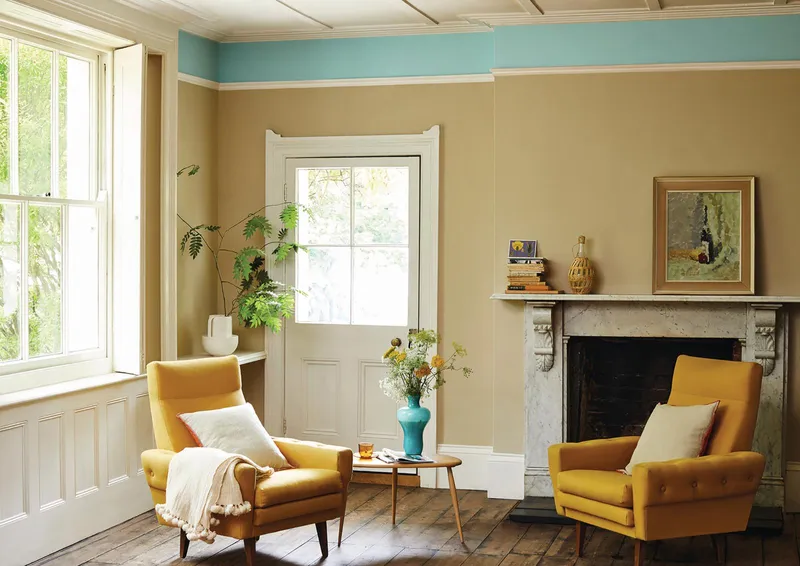
‘The living room is a great place to inject a dose of colour,’ says Cathryn Sanders, head of creative at Earthborn. ‘A classic, grown-up shade like Crocky Road pairs well with a turquoise-blue like Milk Jug, without overpowering the room.’
Add interest with furniture
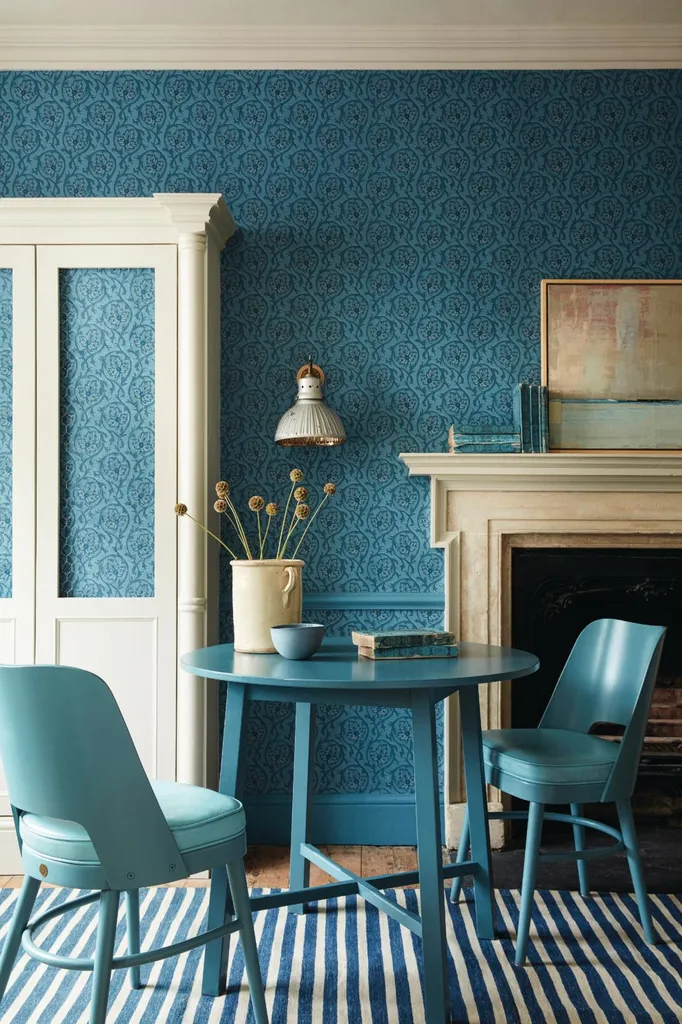
Who says wallpaper is just for the walls? In this elegant living room scheme, Little Greene’s Hoja wallpaper in Air Force Blue is not only used above and below the dado rail, but also features behind the glass-panelled cabinet doors, extending the pattern across the room.
Pattern clash
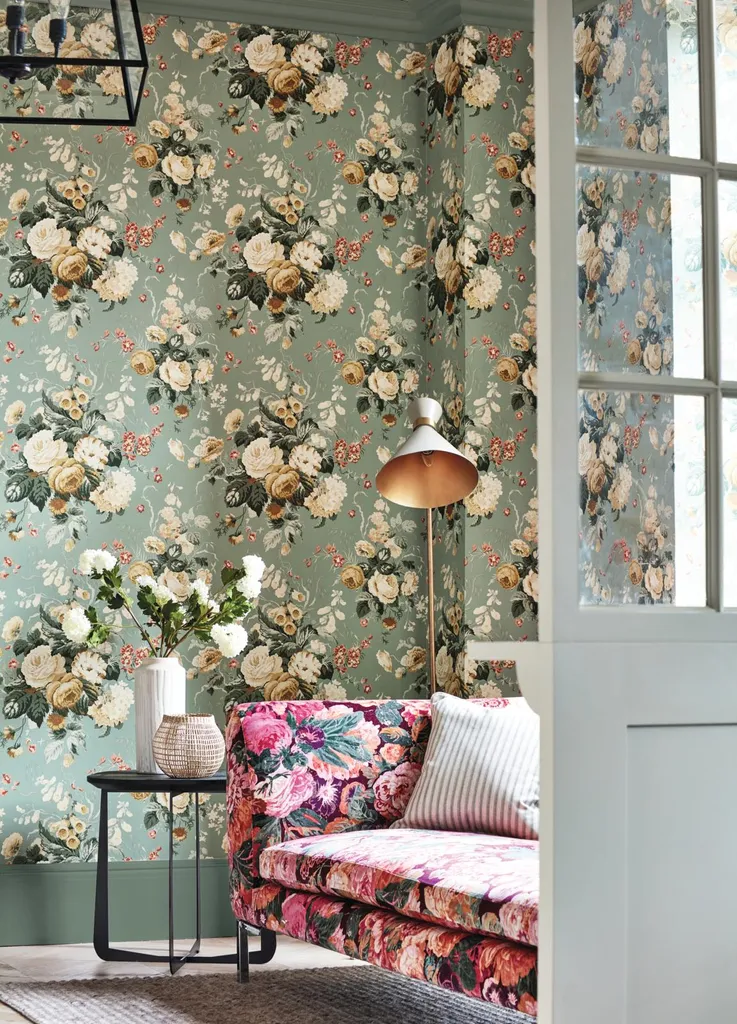
Pairing a busy floral wallpaper – such as Sanderson’s Stapleton Park in Sage/Hone – with a similarly vibrant fabric in a contrasting design, is the perfect way to create a maximalist interior full of personality.
More decorating content from Homes & Antiques
- Beautiful bathroom ideas for a serene space
- Prettybedroom wallpaper ideasto update your space
- Bestheritage paint companiesto have on your radar
- Practicalpantry ideasfor the perfect design
- Guest bedroom ideasyour friends will adore
- Uniqueentryway ideasfor a welcoming space
Sign up to ourweekly newsletterto enjoy more H&A content delivered to your inbox.